#so now i have seen all but one of the native woodpeckers in my area
Explore tagged Tumblr posts
Text
Saw a yellow-bellied sapsucker and a pileated woodpecker for the first time today
#i dont particularly love any of the photos i took of them but hopefully i can photograph them again at this site and do them justice#the pileated woodpecker was huge#i knew they were roughly crow sized but that seemed so wrong that it didnt compute in my brain#when i first saw it flying i figured it was a hawk of some kind just based on size#but nope#so now i have seen all but one of the native woodpeckers in my area#the one i still have yet being the red headed#im not counting lewis's bc its rare it only occurs as a vagrant#so i do not consider it native#super incredible day for animal sightings tho#there was a large flock on wild turkeys foraging in the leaves#and then all of a sudden a coyote popped out and made an unsuccessful attack attempt#it was so unexpected that i unfortunately did not get photos of the attack#(not much of a loss bc the light was too poor to shoot at the shutter speed id need to capture the action)#but i managed to get a few shots of the coyote through the trees#theyre obstructed but they kinda work bc they show the nature of the species#unfortunately parts of the background are blown out bc the backdrop was a white house in sunlight#and i didnt know if id be able to get to a better angle before it left and i probably wouldnt of#my plan is to shoot a forest backdrop from the same location around the same time in similar lighting and composite that into the photo...#...as the backdrop#its rare i actually get the opportunity to watch wild mammalian predators hunting so that was really cool to see even if it wasnt successfu#also got some shots i really like of a swainsons/maybe hermit thrush#i cant quite tell#sadly none of my photos give a good view of the tail which is the main indicator#im leaning towards swainsons bc it seems to have a little more buffy coloration around the eyes than hermit thrushes tend to#but the lighting is a little funky so its hard to tell for sure#and it was in person too so memory doesnt help#edit: after comparing photos im about 80% sure it was swainsons lol
1 note
·
View note
Text
On View
It was evident when I entered the museum that I was the first one there—of the day certainly, of the week perhaps. The young man behind the ticketing desk cast a gaze of both alarm and welcome, the former sentiment only yielding to the latter as I neared and as I spoke confirming myself, I presume, to be of the immediately living rather than the spectrally lingering as he said he did not hear the door when I entered. Though the town of Ellerbe, of which the Rankin Museum is in, declines of late in number, it is far from a ghost town, though perhaps one can imagine many ghosts in the town, leisurely ones probably who “haunt”, in the gentle sense, the spa which first vivified the place, and in the museum, if there is a presence there, it is the founder’s, Dr. Pressley R. Rankin, Jr. (1920-2010), who looks over you from behind as you buy a ticket, lab coat, tie and smile all pressed with an admirable crisp.
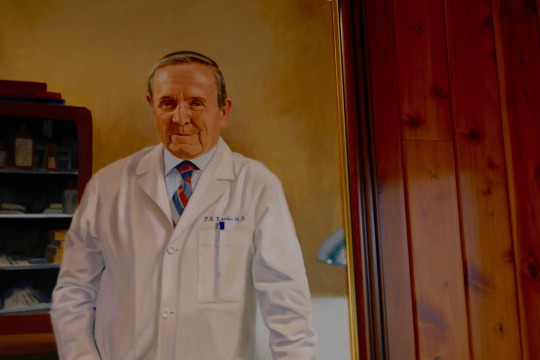
L-, the young man behind the desk, explained to me that the main collection in the hall to my right could be thought of in thirds: one third things the doctor had acquired over his life, one third things donated by local people, one third things acquired; consequently, the division was a third natural history, a third local history, a third Native American history. L-, also apologized if he seemed slow or off, it was just tiredness he said. He seemed ready to explain, but two men entered so I paid my one-dollar fee and began wandering the galleries.
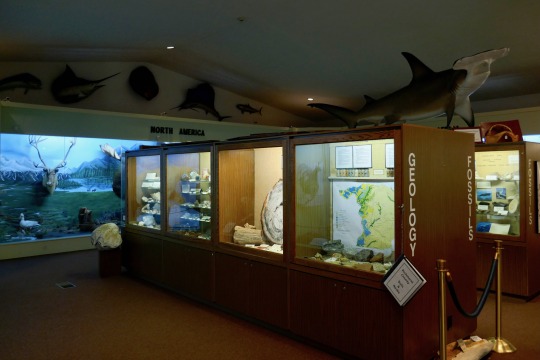
The first thing I saw was a hammerhead shark mounted above display cases of fossils and minerals, its mouth agape. I took it as an allegory of how perception should work in a gallery, for the eyes of the shark, so widely spaced on opposite ends of its head, give it vision in the round, a capacity which fills its belly with food in the sea, but if it, or we, could swim through a museum with such eyes it would fill our thought with inquiry. We could see at once the many minerals on one wall and the display of “First Americans” across from it on the other wall and ponder what the relations between the two could be. We could turn the corner and with one eye look into both eyes of taxidermic mammals expressionless but not quite dead, and with our other eye gaze at fossils of things that lived before nature even considered fur as an option. Swim across the hall and the juxtapositions would continue, shelves of salves, serums and antidotes from early last century—Ramon’s Santonine Wurm Syrup, New Life Pills, The Great Paw Wap Blood Purifier (Infallible Remedy-GUARANTEED)—to your starboard side and to your port side a diorama of the same era’s home entertainments, a stereoscope and cards in a child’s seat and basket serving as another allegory of seeing as the two displays together give some vision of the way the people were at once treated in pain and treated to pleasure.

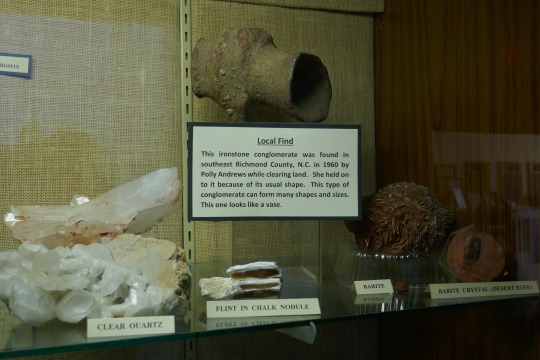
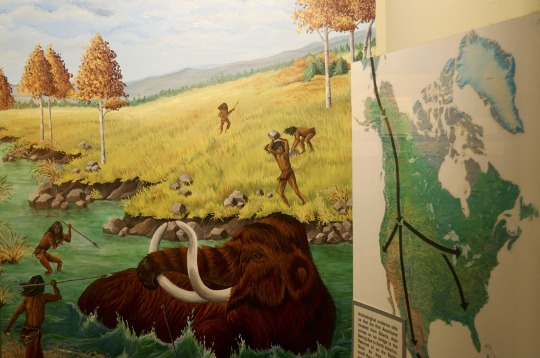
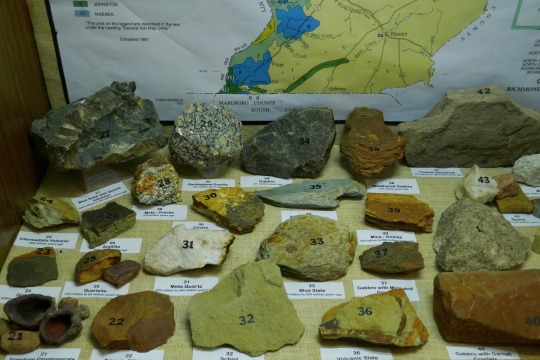
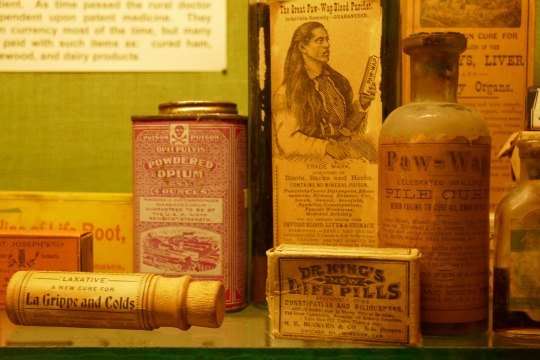
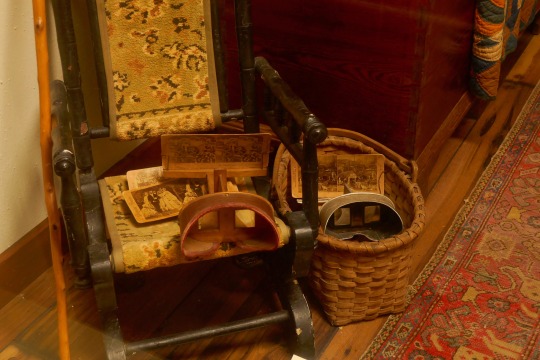
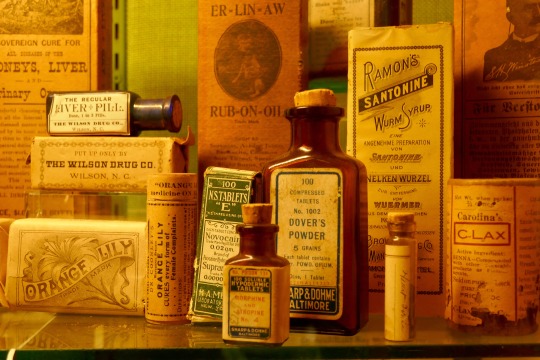
But move a little further and we will want to surrender vision in the round for a narrower kind that stays and stares (or at least I would) coming before the naval stores turpentine still housed behind large glass panes. I did not know it was there (in fact, I knew very little about the museum having only seen it on an old brochure of area attractions left in an even older book back at Weymouth House). Pictures of stills I had seen, but now I could more readily imagine the process of warming the viscose fluid tapped from pines, boiled into spirits of turpentine and the ooze left behind cooled into rosin. The tools of the trade, sifts, spatulas and hacks lay around the still, as do the scarred remnants of long leaf pines which once fueled its profits and fell to its devastation. A fox squirrel, a rattlesnake, a woodpecker and a hornet’s nest also inhabited corners of the display, for these trees supplied not just a place of industry but also provided home for many creatures who, if not for current efforts to plant these pines again, would likely only be seen stuffed and stiff made known by labels.
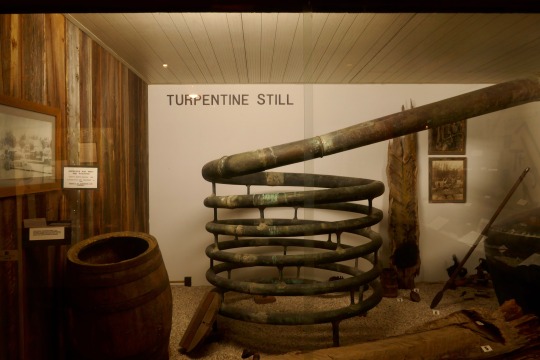
When I did finally turn from the distillery, I was soon stilled again, in the galleries devoted to Native American cultures, for in the middle of the floor was yet another thing I had only known by photograph but never been so close that I could touch it if such were allowed. It was a dugout canoe. You hear the name and think a canoe that has been dug out from the trunk of a tree and the idea seems, at least to me, more fancy than fact even with descriptions of how it was done—fire used to prepare the wood for a hollow, clay to direct the fire, and hard tools of stone or shell to gouge out the flame softened parts. But then to see it, to see the gouges and groves that remain after years and years and years of lying in a lake or in a river after it was no longer ridden in because its makers were ridden away—then fact does not so much suddenly supplant fancy as commingles with it to resuscitate the past, not wholly back into life, but far from its decease.

Other of the objects in those galleries had a similar effect though not conveyed through their singularity as much as through their abundance. Like the minerals, and eggs and fossils of the natural history room, the arrowheads, pottery shards and axes of the Native American galleries were arranged in a way that reminded me of salon hangs—walls of pictures aplenty that seem to work more by a kind of engaged distraction rather focused attention, a visual pleasure of variety and abundance rather than individual frames for contemplation. But though both variety and abundance are usually connotative benefits, the tone of each is inflected by what they describe. So many painting on the wall can at times tend toward a feeling of iteration (another nude, another battle, another table full of grapes), while a multitude of minerals each peculiar in color and geometry soon become a chorus chanting of how unknown the earth remains below. The Native American implements hover somewhere between iteration and the unknown, one shard of pottery seems like another until you realize two may have fit together, created something more than fragments, but even if all these fragments could be reconstructed they’d still be just pieces bereft of what they may have meant and all the things they could have held. There are probably more axe handles present and more space in the canoe than there were members of the tribes that made them in their finals years before disease, death or assimilation caused so many to disappear. The abundance of their things can begin to feel as if they are overburdened with a silence that they cannot yet bear to break to talk about.
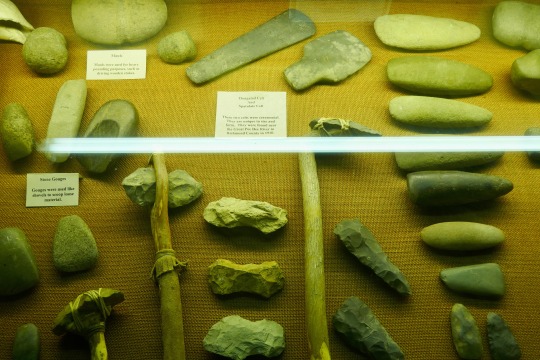
I wish that I could speak with Dr. Rankin ask him on one of the tours he gave until the very end what first thing did he buy, from where and what meaning did it hold for him, ask him as well what first thing couldn’t he buy, from where and would he still want it now. His obituary recounts a life as varied as his collection, a doctor who still made house calls, “delivered babies; set broken bones and sutured wounds in his office; diagnosed all types of illnesses; and became a family friend to his patients”, and a doctor who traveled the world as a surgeon in the Air Force before serving in the local world of county and state, sitting on the board of banks and brick companies, and also heritage sites, the state archaeological committee and its forestry association—in “1983, Rankin was named N.C. Tree Farmer of the Year” and after other accolades he “was a 2006 recipient of an honor award from the Smithsonian Museum of American Indians.”[1] Maybe everything in the museum made sense to him logically in the way they do visually for the hammerhead shark, the world arranged in a spherical comprehension cohering less by dates and lines of provenance than by desire and particularity. Historians I think are shaped much more like cone headed sharks than hammerhead collectors, but the waters of the past are large enough for both to swim.
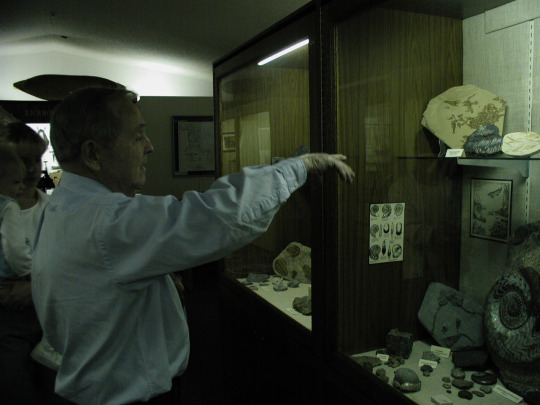
An hour and a half had passed where I thought only a third of that would. It had been awhile since there was another in the galleries—a single man who just looked at the local history; the two men who had entered after me had long since left, truly swimming through the rooms, as they had primarily come to see the special exhibition, which was on the other side of the entrance, and where I went last. It is dedicated to the actor and wrestler Andre the Giant, put up about four years ago, it appears now to be permanent. Though he was dead before I was born, I recall him from film and footage. Looking at the life-size seven foot by four-inch cutout of him one sees a body outgrowing being a body, or at least a body that can support itself—the crutches he used in the last years of his short life lean across from the sturdy cut-out. Andre lived in Ellerbe and once he died his things passed to his friends, who eventually passed them to the museum. So, he counts under the local history category of the collections, though it is hard to think the curiosity of natural history doesn’t also inflect fascination with him, a man with hands that could hold a head as if it were a baseball ball, and probably a sufferance much more vast than even his great size as he bore his body’s pains with a somber smile.
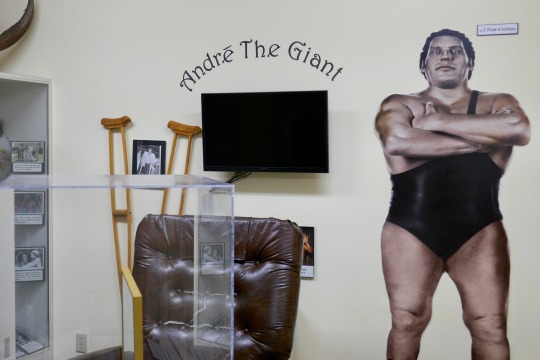
As I started to leave, L- asked me what I thought of the museum, but thought was still mostly feeling as yet able to organize itself with the compact facility of an object label. Yet we chatted for much longer than I thought we would; he told me about his studies in industrial design, showed me the full-size patterns of nineteenth century garments he was drawing right then on a side table, preparing to cut them so that he could later sew them so that he and his friends could wear them even if people in the town did not understand why, he told me about his yearning to leave the town to work in a different kind of museum, he told me, suddenly, that I was beautiful and proceeded to show me the outdoor flume where families often flocked so that children could mine for gems a bucket at a time. Out of the refuse pile, as if it had been waiting to be retrieved, he picked out a small fossil and placed it in my hand. I know not of what creature it was a part, but I hold it as the final piece of my time at the Rankin.
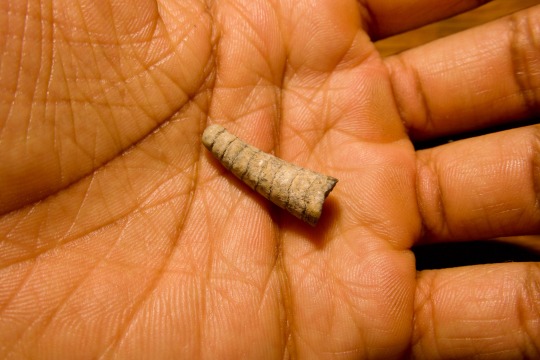
Notes:
[1] See: Pressley R. Rankin, Jr. ’42 – Davidson College – In Memoriam. 9 Oct. 2010, https://inmemoriam.davidson.edu/2010/10/pressley-r-rankin-jr-42/.
Image Credit:
Dr. P. R. Rankin teaches museum visitors of all ages about his collections. November 10, 2001, NC Digital Collections, North Carolina Echo Project. https://digital.ncdcr.gov/Documents/Detail/rankin-museum-of-american-heritage/50766
1 note
·
View note
Text
Spring Birds in Your Backyard
by Annie Lindsay
On spring mornings that I’m not banding birds, I like to sit on my back porch with my binoculars, watching for movement at the edge of the woods behind my house, keeping my ears tuned in to songs and short, usually high-pitched, chip and contact notes. On mornings following a night of heavy migration, small flocks of mixed species often move through the trees, feeding on insects as they refuel for the next stage of migration. These flocks often have warblers, thrushes, tanagers, grosbeaks, or sparrows foraging in their own niches: warblers tend to be in mid- to high-canopy, whereas thrushes stay low and sparrows are often on the ground.
Occasionally, I’ll stand outside in a quiet, dark spot just before dawn and listen for the soft, high-pitched flight calls of migrants settling into habitat after a night of flying. I’m an avid birder: I love to see both new and familiar birds, and watch the species that use my yard and favorite birding patches.
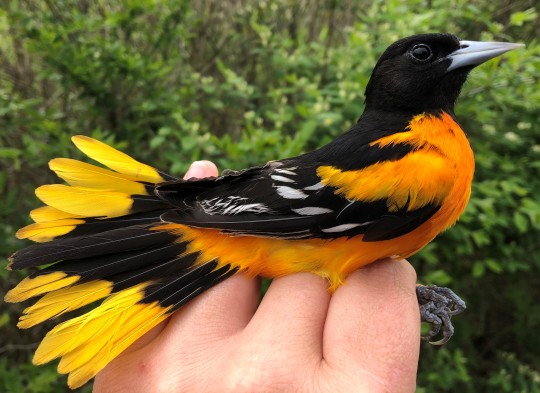
Baltimore Orioles arrive in southwest PA by mid-to late-April. Providing fresh orange halves on spikes can bring them to your feeders from spring through fall migration.
Last year, many people discovered birding. We spent much of the spring working from home, perhaps gazing out of our windows at our bird feeders or backyard plants, and for the first time noticed birds that we didn’t know existed or didn’t realize visited our yards. The opportunity to learn about the diversity of birds in our area and develop a passion for watching them was a bright spot (both literally and metaphorically!) in an otherwise difficult year. The seasons progressed, and now we once again eagerly anticipate the arrival of beautiful and colorful migratory songbirds. Let’s explore common spring backyard birds in southwest Pennsylvania and how to attract and find them!
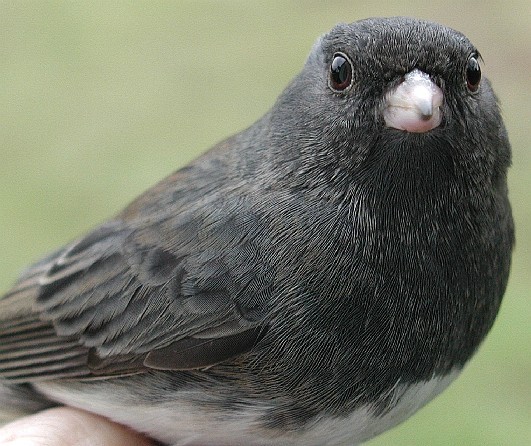
Dark-eyed Juncos are a species we usually associate with winter in southwest PA. They start singing in March, then do an elevational migration up the nearby mountains.
Each year, as the temperature warms, migratory birds move through our area in search of their breeding grounds. Although arrival timing is a bit variable between years due to annual variation in weather patterns, there is a predictable progression of species, so we know what to expect next relative to what we’ve already seen. The first, and often most conspicuous, to arrive are Red-winged Blackbirds and Common Grackles, usually in late February. They are followed by “peenting” American Woodcocks in early March, Eastern Phoebes in mid-March, and kinglets peaking in late-March. Keep your eyes to the sky any time you’re outdoors during these early spring weeks to watch for migrating waterfowl and raptors.
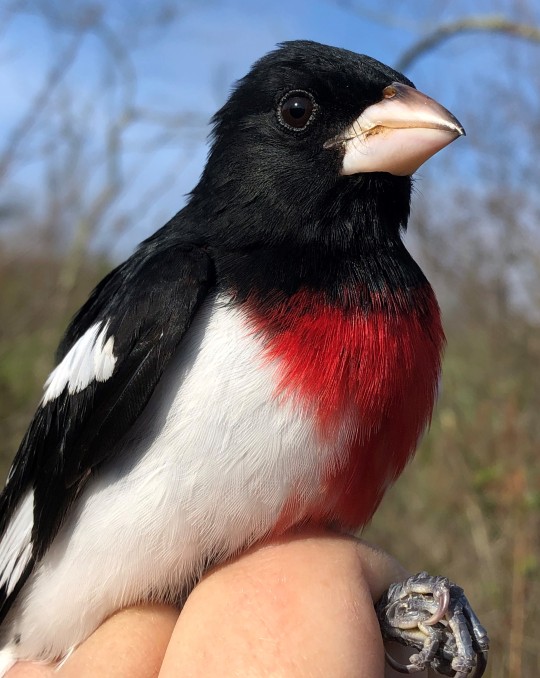
Rose-breasted Grosbeaks readily visit feeders with black oil sunflower seeds or safflower seeds usually in early- to mid-May before moving off into the forest to set up breeding territories.
By April, more songbirds, including vireos, swallows, early warblers, Blue-gray Gnatcatcher (a tiny bird with a wheezy song), House Wren, and the fan favorite, Gray Catbird make their way through our region, many remaining here to set up their breeding territories. In May, the migration floodgates open and some of the most brilliantly plumaged birds we’ve ever seen, like Baltimore Oriole, Rose-breasted Grosbeak, Ruby-throated Hummingbird, Scarlet Tanager, Indigo Bunting, and several warblers, may visit our yards and feeders, along with the less flashy, but equally beautiful, sparrows and thrushes.
Orioles readily come to feeders with orange halves, especially during migration, and seed-eating species like grosbeaks, buntings, and sparrows often visit feeders with sunflower or other seeds (or, in the case of many sparrows, clean up seeds on the ground under feeders!). Hummingbirds come to feeders with nectar (four parts water to one part white sugar, please avoid using food dyes or commercial nectar that has been dyed red). Most of these species are insectivorous, especially during spring migration, and are often observed picking things like caterpillars, midges, and spiders from foliage.
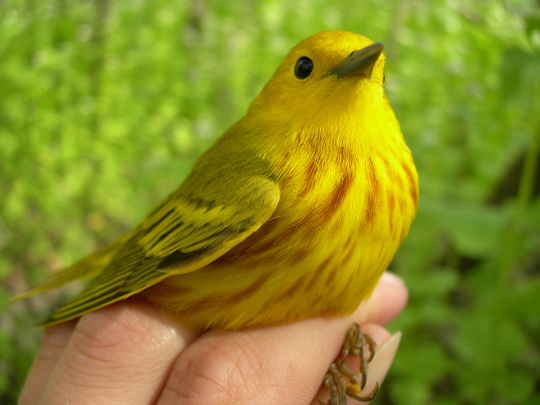
Yellow Warblers are often recognized by their signature “sweet sweet I’m so sweet!” song. You may see them flitting through small woody plants like dogwoods as they forage for caterpillars.
In addition to the migratory species that we see and hear in the spring, many birds that are year-round residents also frequent our yards. Black-capped and Carolina Chickadees, Tufted Titmice, White-breasted Nuthatches, Carolina Wrens, five species of woodpeckers (Downy, Hairy, Red-bellied, Pileated, and Northern Flicker, plus two more if we’re lucky – Red-headed Woodpecker and Yellow-bellied Sapsucker), and the colorful American Goldfinch, Northern Cardinal, and Eastern Bluebird mix with migratory birds. Most of these species visit bird feeders filled with sunflower or safflower seeds (chickadees, titmice, cardinals, nuthatches, woodpeckers), suet (woodpeckers, wrens), nyjer seed (finches), and mealworms (bluebirds, titmice, chickadees).
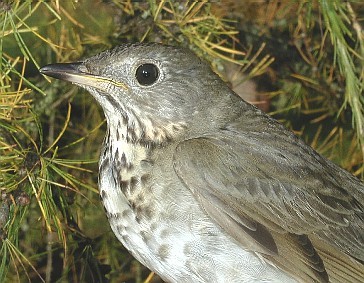
Gray-cheeked Thrushes are cryptic and secretive, but can be found skulking on the forest floor in mid- to late-May before they continue northward migration. They have a beautiful, flutey song and a distinctive call note.
One of the best ways to attract birds to your yard is planting native trees, shrubs, wildflowers, and other plants. Native plants are hosts for a high diversity of insects, especially during their larval stages, and provide nutritious seeds and fruit, all of which are important food resources for birds. These plants are also valuable as cover for safety and nest sites. Although often overlooked, a source of clean, fresh water, as simple as a bird bath or as complex as a pond with a bubbler or waterfall, can make your yard especially attractive to birds. And one of the easiest and most popular ways to attract birds for close viewing is providing bird food in clean, safe feeders. I recommend visiting your local bird feeding specialty store.
You may see all of the birds mentioned in this blog in your yard, but this is a non-exhaustive list and you may even see something unexpected. Visiting a local birding hotspot with complex and diverse habitats is certainly worth the effort as well. Birding these spots several times throughout the season will reward you with an impressive list and will boost your knowledge of natural history. The combination of a good pair of binoculars and a field guide with identification tips, range maps, and text about habitat is one of the best ways to maximize your birding, whether at home or in the field.
Please visit CMNH’s blog page to find bird ID tips and field guide recommendations.
The Audubon Society put together a great guide to the best binoculars at various price ranges.
You can put your bird observation skills to good use (or further develop those skills) by participating this spring in a broad survey of local wildlife and plants called the City Nature Challenge. The observation portion of this event is April 30 – May 3.
Annie Lindsay is the Bird Banding Program Manager at Carnegie Museum of Natural History’s Powdermill Nature Reserve. Museum employees are encouraged to blog about their unique experiences and knowledge gained from working at the museum.
#Carnegie Museum of Natural History#Powdermill Nature Reserve#Birding#Bird banding#Migration#Spring migration#Migratory birds
160 notes
·
View notes
Photo

Lit by early-morning sunshine, the country lane ahead of me is enchanting.
One side is hedge, sweetly fragrant with white hawthorn blossom, and the other, old dry-stone wall, covered in emerald moss, moist and springy to the touch. Every now and then a wren darts in and out of the wall, looking for the perfect space to nest-build. On the ground, life is also starting to fizz. Fresh, tender shoots are emerging. The broad dark-green leaves of foxgloves spread themselves out and a pair of golden brimstone butterflies flutter around the mauve petals of common dog violets.
A misty valley in Borrowdale in the Lake District National Park
I stop for a moment and take a slow, deep breath –thankful to be back in Lake District National Park in North West England. It’s not just me that finds these landscapes so irresistible. Just over 114 kilometres from the thriving metropolis of Manchester, Lake District National Park, at around 2,362km2, is England’s largest, and more than 19 million people from all the over globe visit it annually. Just like me, visitors here are thrilled not just by the region’s spectacular scenery, but also by the rare creatures that live in its ancient oakwoods and the birds of prey that majestically soar the skies.
At springtime, the Lakes – as the area is better known – are especially magical, but it’s a place that beguiles at any time of the year. The otherworldly beauty of its windswept mountaintops, dramatic valleys criss-crossed with idyllic country lanes, sparkling waterfalls and deep, clear lakes often haunts me long after I return home.
Path from Stonethwaite to Rosthwaite
But of all the region’s valleys, it’s Borrowdale that casts the strongest spell on me. The picturesque area, which is situated in the green heart of the Lake District, is a haven for some of Britain’s most endangered flora and fauna. It’s where I am now, and the country lane I’m passing through is in the small village of Rosthwaite, some nine kilometres south of Keswick, the valley’s main town. This is the start of one of my favourite walks, which will take me through a myriad of arresting landscapes, from craggy fells to wild moors, from mountain tarns to oakwoods and, finally, from river valley to lakeshore. It’s a beautiful microcosm of all that the Lake District has to offer.
Borrowdale has thrilled me since childhood. A huge, wild, living playground, it was the perfect antidote to the grey shades and straight lines of school and suburbia. With my parents, brother and sister – as well as our dogs, a young and exuberant Irish wolfhound and a sensible, much older border collie – many happy summer days were spent here. In the meadows, we searched for daisies, buttercups and forget-me-nots for my flower press. And, in the woods, with socks and shoes off , we chased each other around huge oak trees, picking up acorns, throwing them for the dogs to catch, always saving a few to play wonky marbles with later. Then we’d find a clear stream to cool down and clean our hot little feet before starting our adventures all over again.
A ram near Watendlath
Of course, some four decades on since playing in the woods here, it’s sturdy boots, rather than bare feet, for me on my walk today. Now reaching the end of the lane, the view opens out and my climb up Great Crag, a steep fell-side, begins. The colours are different here – less verdant, more of an autumnal palette of faded-purple heather, burnt-brown bracken and grey rocky knolls. The colour of storm clouds. Now, some 200 metres above sea level, I turn around and marvel at the classic Lakes view. The valley floor – which in the summer months is ablaze with wildflowers – is strikingly green, intersected by the shimmer of the River Derwent that snakes through Borrowdale like a silver ribbon.
Turning back towards Great Crag, I follow the bridleway until a large whitewashed farmhouse and a small cluster of stone cottages come into view. This is the secluded picturesque hamlet of Watendlath that nestles on the shores of the tarn here. Apart from a mewing buzzard above me, enjoying the warm thermals, and a gaggle of honking barnacle geese, it’s incredibly quiet.
A blackbird on a wall near Stonethwaite
I take the path around the water’s edge, passing a flock of free-roaming sheep. Huge moss-covered oaks, with branches outstretched like arms and twigs pointing like fingers, cast their shadows. As the terrain turns to moorland, damp and peaty in places, I spy the yellow-green heads of bog myrtle popping above the scrub.
I scan the sky, hoping for a sight of another buzzard or maybe a falcon. It is empty. If I’d been standing here three or four years ago, though, I might have seen England’s last golden eagle, known as Eddie, filling the void. Up until the early 1800s, golden eagles – Britain’s second-largest bird of prey with a wingspan of around 1.8 metres – were numerous in the Lakes. But regarded as a threat to new-born lambs, the birds’ eyries (nests) were systemically destroyed by local sheep farmers – causing such a catastrophic decline in their numbers that golden eagles became locally extinct by the 1850s.
A pair of keen ramblers taking in the scenery
Since then, only very occasional pairs have settled in the Lakes. The last known couple were Eddie and his mate. He is believed to have died in 2016, some 12 years after the female. Fortunately, conservation measures have been put in place to encourage the return of these iconic birds. It’s hoped that chicks from successful populations in southern Scotland will be introduced here soon, turning the Lakes’ skies golden once again.
“Rare creatures live in its ancient oakwoods and birds of prey majestically soar the skies”
After two and half kilometres or so, I see Dock Tarn, one of the Lake District’s most beautiful mountain lakes. Circled by a small ring of tor-topped hills, covered in heather and bilberry, the tarn is aglow in the sunshine. On the surface, some yet-to-flower waterlilies shiver slightly as a light breeze brushes over them. Come high summer, orchids can be found among the grasses, and when the heather blooms, the tarn will reflect their hazy-purple hues, as if in perpetual twilight. It’s not just Dock Tarn that mesmerises. From here, I can also admire the summit of Glaramara and enjoy take-your-breath-away views of other mighty fells, including Haystacks, Honister and Pillar.
An arresting view of Derwentwater as seen from Catbells fell
The Lake District’s natural beauty has quickened people’s hearts for centuries. During the 1800s, some of England’s best-known Romantic poets and writers – including William and Dorothy Wordsworth, Samuel Coleridge, Thomas de Quincey and John Ruskin – were particularly enamoured. They celebrated the Lake District’s sublime beauty in their writings, often elevating the region to a heaven on earth, a wild Eden where man could achieve spiritual harmony with nature. William Wordsworth – probably the most famous Lakes poet, and author of the love song to the Lakes “I Wandered Lonely as a Cloud” – in his great autobiographical work The Prelude, published in 1850, described the region as a place where:
“The solid Mountains were as bright as clouds, Grain-tinctured, drench’d in empyrean light; And, in the meadows and the lower grounds, Was all the sweetness of a common dawn, Dews, vapours, and the melody of birds, And Labourers going forth into the fields.”
A bridge in Rydal
Turning away from the “bright as clouds” view of the summits, I trace a stone-pitched track to the hanging oakwood at Lingy End and begin my descent. The climb down through the ancient wood is steep, and I’m kept company by the babbling Willygrass Gill stream. Originating at Dock Tarn, it cascades gently down the valley, eventually joining the River Derwent. Shoots of pungent wild garlic sprout between rocks and stones, joined by butter-yellow, star-shaped celandine flowers.
“A wonderland I first visited as a girl, I am lured back to the Lake District year after year”
I scan the trees for red squirrels, an endangered native species. Thanks to special conservation programmes, Borrowdale’s woods are one of the best places in England to spot this rare and elusive creature. I also look out for red and roe deer, but as with the squirrels, I am out of luck. I do, though, sight a great spotted woodpecker drilling into a tree, its distinctive black, white and red markings glimmering softly in the dappled light.
A cottage in Stonethwaite
Borrowdale’s oakwoods are the remnants of the temperate “rainforests” that once flourished on the western seaboard of Britain. They are the precious last habitat of disappearing moss and liverwort species and support an incredible variety of ferns and fungi, as well as butterflies, moths and other insects. That’s why Borrowdale’s oakwoods – over 500 hectares, home to more than a hundred bird species – are afforded the highest tier of protection available to habitats in Europe.
After an hour or so, the steepness of the slope eases and I’m back on level ground in the village of Stonethwaite, just next door to Rosthwaite. The wide walled and pretty path here runs parallel to the River Derwent, considered one of the purest rivers in Europe. Freshwater shrimp, lamprey and salmon thrive in its protected waters – even sleek-haired otters, once locally extinct, are back and can sometimes be spotted on the riverbanks with freshly caught fish in their paws.
Two people fishing at a reservoir in Watendlath
Back at Rosthwaite, I jump on a bus and less than 10 minutes later find myself on the shores of Derwentwater, one of the Lake District’s fi nest glacial lakes. In the afternoon light, the water reflects the shape of the mountains that circle it. A swan glides by, heading towards Lord’s Island, one of the lake’s four main islands. Once inhabited by the Earls of Derwentwater, the island is now a desirable residence for nesting birds and primroses only. During the winter months, the secluded bays and headlands here provide shelter for many wildfowl, including greylag geese, mallards and moorhens.
The Queen of the Lakes, as Derwentwater is also known, is the only place in England – apart from Bassenthwaite Lake about 16 kilometres further north – where vendace, a rare Arctic fi sh species dating back to the Ice Age, survives. Bassenthwaite Lake is also the place to see the Lake District’s only ospreys. These spectacular birds of prey, with a wingspan of almost 1.5 metres, returned to breed in 2001, after an absence of almost 150 years, and during the summer months can be seen diving for fish in Bassenthwaite’s pristine waters.
A river scene in Rydal
Two years ago, in 2017, the Lake District National Park was designated a Unesco World Heritage site. It became a National Park in 1951, one of the first established in Britain after the passing of the 1949 Act of Parliament. This year marks the 70th anniversary of that Act, without which the UK wouldn’t have its 15 glorious National Parks to explore and enjoy today.
That the Lake District is – and remains – a protected place is important to me. The Lake District is a gift. A green refuge where once-lost species have returned; a precious jewel of a place where I, and countless others before me, have felt at peace and been inspired, and found gentle reminders of a more natural past. A wonderland I first visited as a girl, I am lured back to the Lake District year after year. And each time I return, I fall back in love – bewitched all over again by the “empyrean light” of the Lakes that shines forever bright, captivates completely and re-wilds my heart.
SEE ALSO: Why Manchester is the UK’s next creative powerhouse
This article was originally published in the June 2019 issue of SilverKris magazine
The post Over vales and hills: The enchantment of the Lake District appeared first on SilverKris.
2 notes
·
View notes
Text
LENOIR PRESERVE
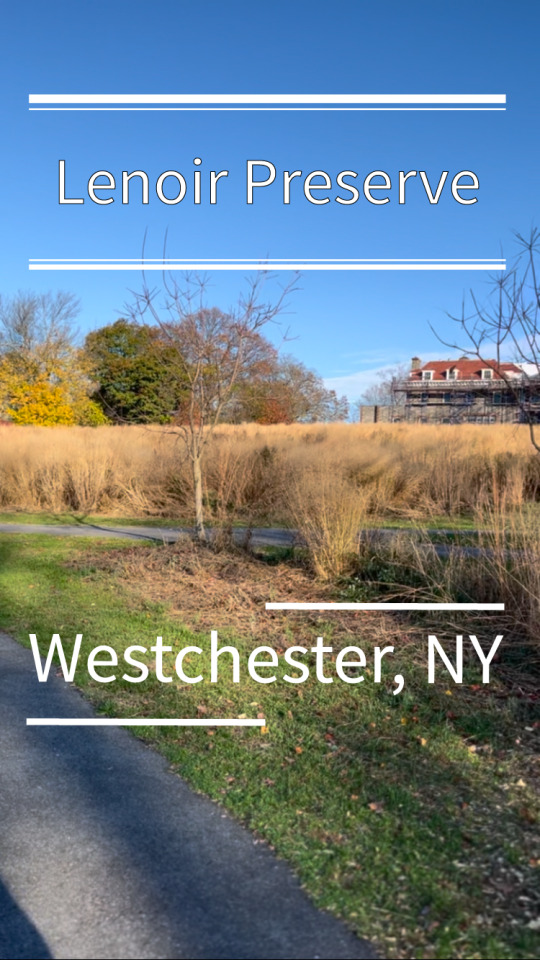

Sometimes its really fun for me to introduce my boyfriend, Rob, who grew up in the area, to places in Westchester that he didn’t know existed previously. Lenoir Preserve is one of those places and I DO think passing by it in the car and saying “what was that?”, him shrugging and me saying “let’s check it out” absolutely counts.
💰 : FREE
⏰ : open dawn to dusk, 365 days a year
🌎 : 19 Dudley St, Yonkers, Westchester
♿️ : ADA accessible and handicap specific spots
🏃♀️: please see link in bio for trail recommendations and intensities
🐶: service animals only, no pets
🚗 : parking lot on North Broadway by the mansion, parking lot on Dudley Street (off N. Broadway), by the Nature Center
📸 : moderate Instagramability, depending on your willingness to “break rules”
📍: Weckquaesgeek, Wappinger, Lenni Lenape ancestral home
The most recent time I came here with Rob, after I had decided to make this account, I looked at him as we were walking through the park and said “I don’t know how to sell this place when Untermyer is right down the road.”
I still don’t really know how to sell it if you’re comparing it to Untermyer. Like, how do I convince someone who’s driving to the area to go here instead of Untermyer? The only mind-blowingly unique part about Lenoir Preserve is that Rob and I have seen a bald eagle there twice now.

Lenoir Preserve has a few dedicated paths, one of which is very easy and nicely paved, one mansion that’s on the property (and under restoration currently) and a second mansion (that’s under restoration) with beautiful and dilapidated gardens that’s not.. quite… ON…. The property…., (more about that to come next) and is a really spectacular place to see some great birds, year round. Lenoir also has a dedicated butterfly garden, but that’s only really worth the visit in the summer months. As a park that has access to the Old Croton Aqueduct, it obviously also has fantastic views of the Hudson River and the Palisades across the way.
BUT, it has none of the grandeur or maintained, manicured gardens of Untermyer.

The sell for Lenoir Preserve, that I’ve been able to come up with is the following:
Untermyer draws a lot of tourists and a lot of people taking professional photos and a lot of people taking pictures for their Instagrams, and Lenoir is not like that and sometimes that is SO REFRESHING.
Lenoir has really nice and well-maintained trails, that run the gamut of intensity from beginner to moderate
At least one bald eagle most definitely lives there, and I’m sorry, you don’t get how cool they are until you see them in person.
The bird feeders. We all know I’m a boring old person who loves me some birds but that’s a draw for me and if it’s not for you too, I don’t care. Let me love my birds, okay?
Lenoir Preserve is insanely steeped in history but really it’s the nature that makes this park so awesome. Every park is special because nature should be cherished and preserved every chance we can get. Lenoir wouldn’t be so spectacular if you weren’t able to “smresspass” onto the Alder Manor garden ruins, or if there weren’t freaking bald eagles and what feels like millions of woodpeckers, or it’s peacefulness compared to Untermyer, or its access to the Old Croton Aqueduct Trail, HOWEVER, Lenoir HAS all of those things, so it is 100000% as worth your time as its better known sibling down the road from it.
HISTORY:

Lenoir, as a piece of land, has an interesting history dating back to before the colonization of North America. The land was most likely originally home to the Weckquaesgeek, who were a part of the larger Wappinger tribe who generally lived in the Yonkers area. The informational plaques at Lenoir Preserve indicate that the land was originally inhabited by the Lenni Lenape tribe (translates to “true people”) and they called the area “Keskeskick”, which isn’t necessarily wrong as the Lenni Lenape is a broad name for any native who lived between essentially the Hudson Valley down to the area around modern-day Philadelphia.
I don’t know the exact details, I’m sure they involved trickery, violence or misunderstandings, so I’ll put it in the nice way of saying, the Lenni Lenape were “pushed” out of the area in the 1600s and eventually a man named Frederick Philipse III, whose family had acquired the land two generations prior, then owned the property of what is now known as Lenoir Preserve.
Frederick Philipse III was a loyalist and in 1776, he signed the “Declaration of Dependence”, pledging his loyalty to the King of England. And, I imagine if you have stumbled upon my blog and are from the New York area or even just have even a rudimentary knowledge of U.S. colonial history, you would understand that 1776 is when everyone was like, “fuck the King and fuck England.”…..
So, I think you can probably guess how things went for Mr. Philipse III since we, inhabitants of the future, know who won the American Revolutionary War…
As happened to many Loyalists in the Westchester area, Frederick Philipse III had his land and home stripped from him and it was sold off to two different families. In theory, according to the Lenoir historians, you can still see some of the ruins of the earliest stone homes built by the Philipse family and by the people who gained his property after him. I’ll admit though, I haven’t found those ruins yet as far as I’m aware.
Let me know if you do.
The mansion that sits on the property of Lenoir Preserve has been around since at least 1836, or at least that’s the first time it appears on any written record. It changed hands many times until Caleb C. Dula, a native of Lenoir, North Carolina, who amassed his wealth in the cigarette industry, bought the property in 1906. He named the mansion and property “Lenoir” after his hometown.
In 1939, the Lenoir property was inherited by Mr. Dula’s niece, Mrs. Purl Wightman, who renamed the mansion after her husband’s surname but allowed the property as a whole to retain its Lenoir identity. As goes everything in New York, it seems, real estate developers caught wind of an eventually empty estate and attempted to demolish the history and create apartments or a country club.
Thankfully, the city of Yonkers and Westchester County decided to intervene and bought the property instead, allowing it to be turned into a nature refuge and museum. The interiors of the mansion have also since been used as the setting for TV shows like The Knick and The Following.
TRAIL RECOMMENDATIONS:
My preferred trek (very beginner intensity): I advise parking in the lot located off Dudley Street. From there look for the trailhead sign for the Copper Beech Trail (0.2mi) straight from the parking lot (if you hit the Nature Center, you’ve missed the trailhead, turn around, it should be on your right if your back is facing the Nature Center). Take the Copper Beech Trail to the Meadow Loop paved path, which does in fact loop all the way back to the Dudley Street parking lot.
IF you are feeling a little dangerous, perhaps you might partake in some light adventuring (AKA a word that rhymes with smresspassing… I deny EVERYTHING!) into/over/around/through the brick wall that denotes the property line between Lenoir Preserve and the old Alder Manor estate property.
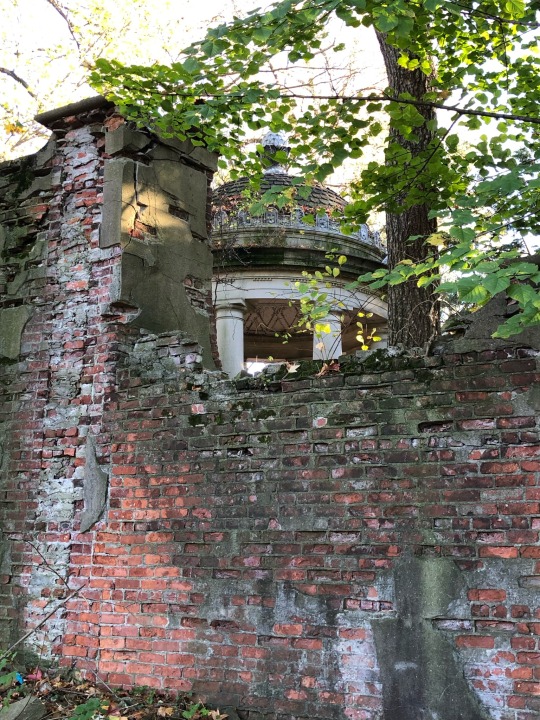
There ARE cameras so “smresspass” with caution… I feel like as long as you don’t vandalize anything, who cares if you take a little peek… right????
No?
Okay, well anyway….
Don’t forget to keep your eyes to the skies throughout your stroll, as this preserve is very well known to be frequented by red-tailed hawks and AT LEAST one bald eagle, and also like a million woodpeckers.
An important stop for Rob and I, or really just me, before we head back to the car is the bird feeders outside of the Nature Center, which is where Rob and I first spotted the bald eagle actually. He wasn’t eating bird seed… but we were sitting there and he flew over, and Rob saw him first, which I think he would want me to mention.
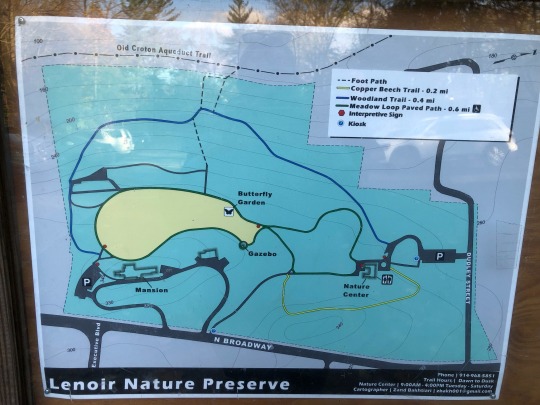
MEADOW LOOP TRAIL: The Meadow Loop Trail is easily accessible from both parking lots and is paved in its entirety making it beginner and ADA friendly.
WOODLAND TRAIL (0.4 mi): it’s a quarter of a mile, Cat, how bad could it be? Like I’ve said before, Rob and I are what you’d call “lazy active” people and this trail is STEEP… like REALLY REALLY STEEP. I was huffing and puffing and my old lady knees were HURTING by the time we got back up to the top. HOWEVER, if you’d like to partake in some of the Old Croton Aqueduct Trail or even walk down to Untermyer, that can be achieved by taking the Woodland Trail and going south (left, if you’re looking at the Hudson).
COPPER BEECH TRAIL (0.2mi): a wooded walk with very mediocre “elevation gain”. Also the place I suspect the eagle has his nest.
Lenoir does not necessarily make my "Run, Don't Walk" list. But that doesn't mean I don't love it and think it's worth a check out.
#lenoir preserve#aldermanor#alder manor#lenoirpreserve#westchesterny#westchester#westchester ny#westchester county#yonkers#yonkers ny#yonkersny#parks#bald eagle#butterfly garden#hudson valley#lenni lenape#cathikesny#new york from a new yorker#newyork#new york#park#preserve#wildlife#birders#birding#bird
1 note
·
View note
Text
What strange animals might you find?
Allegedly named for its resemblance to the old German emperor Wilhelm II, the Emperor Tamarin boasts a long white moustache- earning the species it’s title as a ‘strange’ animal. The species flips the switch when it comes to breeding- and while most animals are monogamous, having one partner. The Emperor Tamarin has a Matriarchal structure with a dominant female breeding with several males.

The ‘screaming hairy armadillo’ has a strange name, derived from it’s tendency to scream- I’d assume. However what is strangest about this Armadillo is the fact that 50% of what may occupy its stomach at any given time may in fact be sand- consumed as it feeds on those that hide within it.

The Aye-Aye is a nocturnal creature who hunts in a way similar to a woodpecker, using percussive foraging as a means to track down it’s food. With rodent like teeth the Aye-aye gnaws into trees and reaches into the holes it creates with it’s nimble fingers- pulling out grub for it’s meal. However the strangest part about the Aye-aye to me is the bug-like eyes that look as though they have seen the answers to the universe and walked away physically unscathed but not mentally.

https://www.thedodo.com/the-5-worst-zoos-in-the-world--528392319.html
Are all zoos ethical? Treat animals well? Conform to guidelines? Why not? 2 stories about cruelty.
Unfortunately not all Zoo’s are ethical in their exhibition of animals. An example of this is ‘Surabaya Zoo’ located within Indonesia which is been oh so charmingly labelled ‘The World’s Cruellest Zoo’. One of many incidents includes a young tiger found hung in it’s cell, and another incident includes a Tiger being fed meat laced with Formaldehyde. A chemical often used for preserving the dead but is also highly toxic upon consumption and potentially even linked to cancer risks.
No matter how horrible it is, unfortunately some Zoos just don’t care for their animals to the extent they should, with many Zoo’s sticking to the outdated practice of small cages rather that creating a mimicry of a natural environment which is much healthier for the inhabitants of the exhibition.
An example of this cruelty is ‘Giza’ Zoo, in Egypt. Where animals are kept in cramped conditions and refused the exercise they rightfully need for their own wellbeing both physically and mentally. With countless inspectors shaming the zoo, it lost it’s membership with the World Association of Zoos and Aquariums in 2004.
There is no way to understand why anyone wouldn’t agree to conform to the guidelines given to them, and all I can assume is a rampant lack of humanity.
https://scribol.com/anthropology-and-history/bizarre-and-offbeat-news/20-most-ridiculous-zoo-signs -on-earth/6/
How does signage differ in zoos? Discuss.
With the initial difference of the staff who run the Zoo, there is the immediate expectation of signage being unique to each location. However, one of the more noticeable differences between signage relies solely on if the staff have a sense of humour or stick to being formal. And example of this is this sign.

While this sign is just a blue background with simple Papyrus text, likely made very quickly in Microsoft word by a tired employee- there’s a sense of humour to it, while also expressing a desire for the public to stop littering in the area that this sign is posted at. In some cases it is easier to make society listen if you make them laugh while doing so. In a case such as this- despite the low quality of the sign. I’d say it’s likely gotten some good results.
Another example of a ‘funny sign’ that you can tell originates from a tired employee trying to make a statement to uncaring customers is this. Once again the humour catches the eye of a previously ignorant customer- the joke sticking in their mind and reminding them to behave. This sign is more well made- the text is bolder and the contrast of red on white is more eye catching than the previous sign. This carries a more profession atmosphere to it.

2 stories about guests/visitors in zoos (comment).
https://www.youtube.com/watch?v=PSKevgNg3xI
This youtube video covers five guests in various Zoos who seemed to be lacking in common sense.
One example is the man who broke into the Panda enclosure, likely under the assumption that the panda is a harmless soft bear- He was thoroughly surprised when he found out that Pandas can be violent when it mauled him. He was lucky to escape alive, of course. But there are very specific reasons that animals in zoos are physically kept away from humans who aren’t their keepers.
Another example is of a mother who did not watch over her child and as it fell into a gorilla enclosure- the confused gorilla tugged the child around. This is no Tarzan story, and the gorilla was not nurturing towards the child. This begs that parents be more aware of their children at Zoos because tis recklessness ends up getting the curious animals killed.
Good and Bad Zoo Maps
Nashville Zoo map

This map feels like a confusing cluster of small fonts and almost indistinguishable markings supposed to represent enclosures. The abundance of information stored on tis map is overwhelming to me, I struggle to process what this map tells me and as a result- If i were at this zoo I would frequently be lost and stressed out by this map. This map is closer to a road map in my opinions, trying to provide too much information to a point where it’s counterproductive.
Toronto Zoo map

Toronto zoo’s map utilises colour coding in order to help let you know where you are, and I’d imagine in the zoo in person there would be occasional coloured markings to let you know where you are. The colour coding successfully separates the enclosures into identifiable groups in correlation to their shared habitats which i find to be subtly educational as well as incredibly helpful and makes the information a lot easier to process. There is not too much attention to detail in relation to paths and such- instead this map focuses mostly on the enclosures and how to best display them in a findable way.
While some of the font is quite small, there’s larger fonts used for the important parts of the map such as declaring the habitats, the silhouettes of the animals in those areas makes it so that filling the page with words such as ‘elephant enclosure’ countless times for different species is unnecessary. As you can simply be guided by the silhouette of the animal- which is also a nice use of graphics.
From small to large – how do small scale rescues turn into public enterprises? Case Study.
With Shepreth Wildlife conservation as an example, the park began as a small private sanctuary helping a young, injured, Jackdaw. Others soon followed and joined the little ‘family’ at the sanctuary. As their responsibilities increased so would funds needed, and space, and more. Eventually the sanctuary got bigger and bigger with more responsibilities including animals that couldn’t be released back into the wild but needed looking after. They soon opened up to the public as ‘Willers Mill Wild Animal Sanctuary‘.
With a 35 year running hedgehog rehabilitation, the project outgrew it’s facilities and a charity known as The Shepreth Wildlife Conservation Charity (SWCC) was founded. Which funded the Hedgehog Hospital.
The facilities are used as charity fundraisers in order to continue helping the abundance of wild animals they save.
Zoo or safari park? Which is better? How do they differ?
While Zoos keep animals in cages and don’t let them experience the true depths of the wild, Safari parks let animals have those experiences, they don’t keep them separated in cages and instead replicate the true experience of the wild, while letting tourists and patrons continue to observe the animals in their natural habitat or something incredibly close to it. (while the patrons are in a vehicle of course.
I find personally that Safari parks are better and more humane for the animals within them. As they get the closest experience they can to being in the wild and even hunting- Safari parks also eliminate the concerns of animals having too little space in the cages Zoos keep them in. Safari parks and especially Woburn as an example, have a large amount of land. Woburn having 300-Achres for the animals to roam and explore. Allowing for optimal levels of exercise and freedom.
Unusual zoos
The biblical Zoo: The Tisch Family Zoological Gardens in Jerusalem, also known as Jerusalem Biblical Zoo- is home only to animals mentioned in the hebrew bible. Unfortunately due to many animals mentioned within the bible being extinct- maintaining this premise is growing difficult. However there’s also the issue of the vagueness of animals mentioned within the hebrew bible causing confusion for what animals were actually meant. Not only does this zoo hold biblical animals but also biblical shrubs and plants. While unusual, I respect this concept and the fact the Zoo follows a theme rather than just being out there purely to gain money is interesting to me.
Old Macdonald’s farm: Much like the childhood song you would sing, Old Macdonald’s farm is a real place which showcase farm animals such as cows, sheep, and pigs. As well as Fowl native to Virginia (where the farm is located).
The farm’s goal is to expose children and adults the like to a farm setting which they would previously not have had as much exposure to, in order to educate and teach the processes of farming and raising such cattle.
While this isn’t a Zoo in the sense you’d think of, hosting tropical and wild animals. The Aim to educate is still there and as such this would be classed as an unusual zoo.
Flamingo Land: Flamingo Land is a combination of an amusement park, resort and Zoo. Founded in the 1950′s, this park was named for it’s colony of pink flamingos. The Zoo is now home to over 120 species of animal. The zoo aspect of this park is only one of it’s many facets. The park also Hosts over 50 amusement park rides and attractions, three shows, and even a swimming pool.
0 notes
Text
AX2222 - Creating a woodland creature: research
In order to create a design for an animated woodland creature, research into existing woodland creatures was necessary. I wanted to avoid making a mammal, so focused primarily on birds; my reasoning being that a significant proportion of animated characters based on animals tend to be mammals. For example, Mr. Fox from Fantastic Mr. Fox is, unsurprisingly, based on a fox, Simba from The Lion King is based on a lion, Sonic The Hedgehog is based on a hedgehog etc.
One of the reasons that mammals are common subjects is that as mammals ourselves we are capable of more easily associating with creatures that share similar body plans. You could look at the expression of a lion and be able to guess what it’s thinking about. However, to the human eye, creatures such as lizards, and indeed birds, are much less facially expressive naturally, not that it’s impossible to see it though. This is, however, my personal observations. I was unable to find a study to back up my claim.
My first, and for a while favourite, idea was to base a character on the Red Capped Manakin; a small, tropical, forest bird whose closest relations in the United Kingdom include birds such as the Great tit, Blue tit, and Coal tit, all of which belong to the Order Passerine.
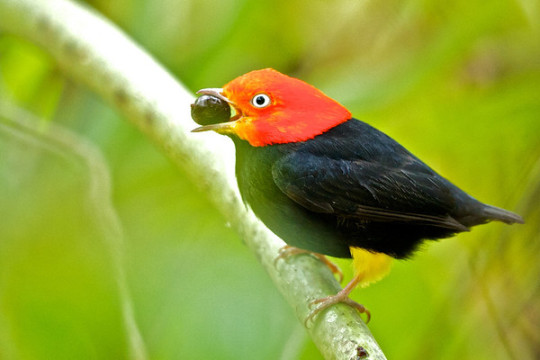
I particularly like this bird because it is my opinion it has a very unique look: a bright red head contrasting with its dark black body and white-blue irises, added to this is the bright yellow colouration of the tail feathers.
What is more, this bird is capable of performing a remarkable shuffling dance along branches, which I have often seen referred to as the moon walking of the bird world. It uses its skills in dance to attract females, and dissuade rival male birds. (McDevitt et al., 2019)
Continuing with the theme of brightly coloured birds, I next turned to the UK’s Green Woodpecker. Woodpeckers are a remarkable group of animals in and of themselves; with a spongy mass at the base of their bills to soften the impacts as they drill into wood, and a dexterous tongue that is of such extraordinary length that it is necessary for it to wrap around the top of their skull. But what set the Green woodpecker apart for me was a combination of its almost fully green body, a colour pallet not commonly found on birds native to the UK, and it’s call; which sounds like a mocking laugh. (The RSPB, 2019)
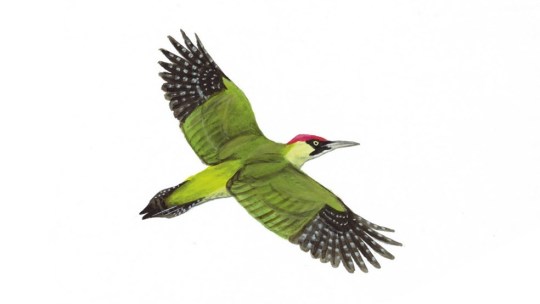
The next bird I looked into for my research also has a green body and brightly coloured cap, but is almost four times smaller than the Green Woodpecker: the Goldcrest, the UK’s smallest bird. The Goldcrest likes to seclude itself in arboreal conifers for large portions of their lives. As such, while the RSPB classifies them as a common bird, many people don’t see them. Furthermore they sing at such a high pitch that people start to lose the ability to hear them around the age of 40. (The RSPB, 2019)
Reclusive, this bird enjoys a life missed by large portions of the population.

Another bird that shies away from humanity that I researched was the Jay. Like the Goldcrest, Jays are secretive, and masters of not being seen. While they belong to the crow family they are much more colourful than their more boisterous cousins; adopting a wooden pallet of light brown, black, and white, with their most striking feature being the glossy bright blue flash on the leading edge of their wings. (The RSPB, 2019)
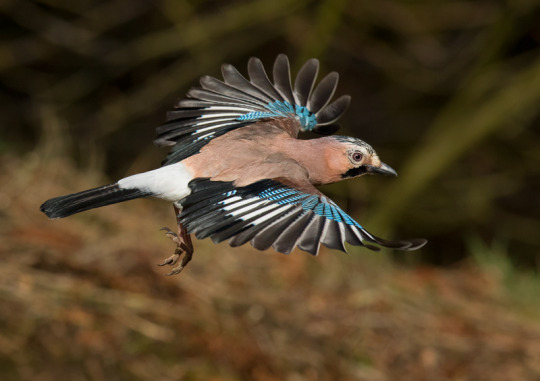
Another interesting trait of the Jay is their symbiotic relationship with the Oak tree. During the autumn the Jay begin its preparations for the winter, a time where food is very scarce. It gathers acorns and buries them, memorising the local landmarks and distances from them so that it can dig them up later. However, much like humans, it does not have a perfect memory and so will forget about some of the acorns it buries. As such new oak saplings will begin to sprout from where the Jay had buried them in the previous autumn.
For variety I also did research into a number of other animals from different walks of life. Firstly a representative of the Phylum Arthropod. A Phylum is a group of animals with a defining body plan: all mammals are Chordates, coniferous plants are Pinophyta, and insects such as the woodlouse belongs to Arthropoda.
In the UK alone there are 9 types of terrestrial woodlouse, though one species I found to be of particular interest was the Pill Woodlouse. It has an interesting defence mechanism that it shares with Hedgehogs, Armadillos, and Pangolins: when threatened it curls up into a tight ball, leaving its smooth defensive plating as the only part of the animal exposed. When left to its own devices it will scavenge dead organic matter to consume. (Nature Spot, 2019)
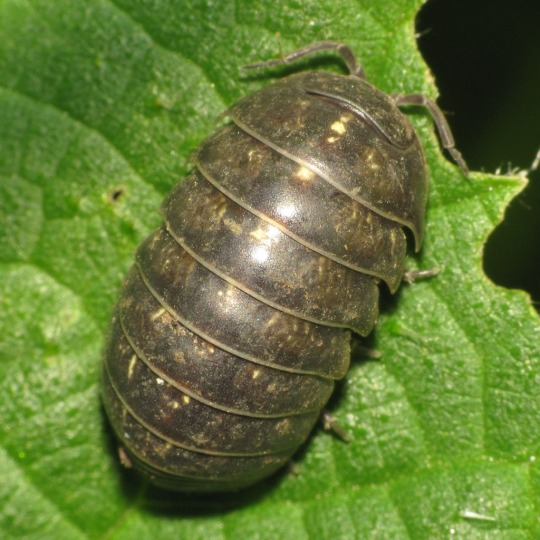
Next, I decided to move onto mammals. After much consideration I decided to start research into the Pine Marten: a small, weasel-like mammal that pursues a semi arboreal life largely thanks to its semi-retractable claws, a trait unique to Martens in their family class.
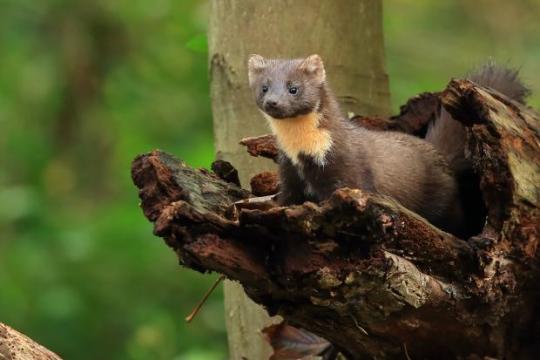
Opportunistic, the Pine Marten will consume most creatures smaller than it, including birds, insects, and smaller mammals, which is not to say that the Pine Marten is limited to live pray as it will happily also scavenge carcases, eggs, and berries. (Wildlifetrusts.org, 2019)
I personally saw potential for a character based on this animal to be an active, interested, opportunist, rather than the typical portrayal of relatives of the weasel to be scheming, conniving and underhanded.
Following this thought process I focused on another animal often portrayed as inherently malevolent: the bat. In this case specifically the Common Pipistrelle. Aeronauts of the night time forest, the Pipistrelle relies on not sight to navigate and hunt its prey, though it does have fully functional eyes, but echolocation: a process of sending out a sound and listening for what sounds echo back to determine how far away something is and how big it is. Dolphins also employ echolocation, and even humans are capable of learning to echolocate. (Wildlifetrusts.org, 2019)
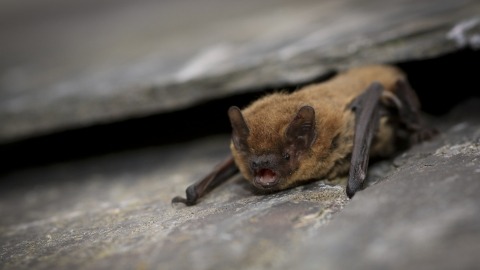
Remaining with creatures that are capable of flight, I returned back to birds, but now with less of a focus on the bright colours of the bird. This time I considered an odd, and rare species of Grouse that is only to be found in the highland woods of Scotland: The Capercaillie. This animal was of note to me for a couple of reasons.
Firstly, without a size reference, to my eye at the very least, images of the bird makes it look deceptively small. In reality it is almost twice the size of the much more common Ring-Necked Pheasant - a bird that most people who live in or visit the countryside will be familiar with. The Ring-Necked Pheasant weighs up to 1.7 Kg, where as the Capercaillie can weigh up to 4.3kg. (Wildlifetrusts.org, 2019)
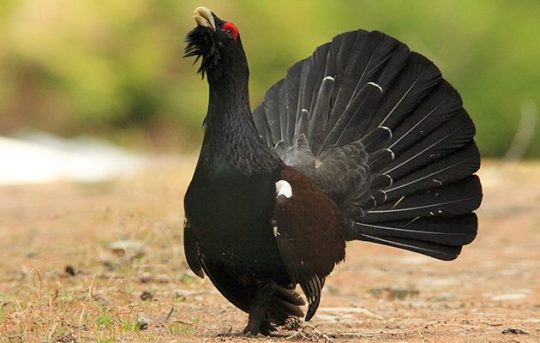
Secondly, I was attracted to the idea that the bird lives in a very, very specific area of Scotland. So I contemplated the possible outcomes of what would happen if a character based on this animal were to be somehow displaced from the small woodlands that it calls home.
Thirdly, and this it what brought it to my attention in the first place, the animal makes a remarkable noise. The sound is that of a series of glass marbles being dropped down a tube followed by a tape recorder rewinding.
Unfortunately it would be difficult to work in the sound of the Capercaillie into a story where there would be an active character with dialogue.
Finally, we come to the animal I have selected for adaptation: The Bowerbird. Some Bowerbirds create wondrous art to attract a mate, and the two that I focused on were the Satin Bowerbird and the Vogelkop Bowerbird.
The male Satin Bowerbird bears a physical resemblance to the Jackdaws of the United Kingdom, however it’s bill is of a different shape and colour, its feathers have a shimmering blue gloss, and it’s most striking feature is its eye: bright violet in colour. It constructs a Bower in a small flat plane, and then surrounds it with objects of the brightest blue. In nature petals, berries, and feathers were favorite, it would even create a blue paste from fruits to paint with to make things blue. Now, however, the world has changed. The Satin Bowerbird has become a thief of human waste; stealing bottle caps, pen lids, and plastic cutlery to decorate its bower with. Resources far easier to find than blue feathers. (The Australian Museum, 2019)
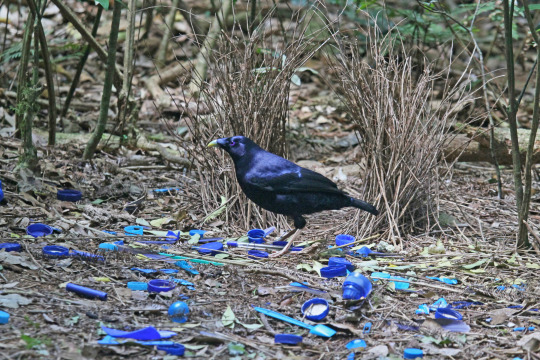
The Vogelkop Bowerbird also gathers objects to show off, but unlike the Satin Bowerbird the Vogelkop Bowerbird is not limited to one colour and as such each display is unique to that animal and it’s tastes. No two displays will be similar, some will be piles of a particular red flower, while others may use beautiful fruits. What is more, is that it spends years of its life creating an art museum made of sticks and twigs for its displays. Truely, the artisan of the bird world. (Life, 2009)

I have several ideas that I intend to develop further surrounding the Bowerbird. A thief who steals something important, an artist that wants to paint with the colours of the world, or even a mixture between the two. However, for now I have a base for a character.
Bibliography: McDevitt, M., Rodríguez-Flores, C., Soberanes-González, C. and Arizmendi, M. (2019). Red-capped Manakin | Neotropical Birds Online. [online] Neotropical.birds.cornell.edu. Available at: https://neotropical.birds.cornell.edu/Species-Account/nb/species/recman1/overview [Accessed 10 Oct. 2019].
The RSPB. (2019). Green Woodpecker Facts | Picus Viridis - The RSPB. [online] Available at: https://www.rspb.org.uk/birds-and-wildlife/wildlife-guides/bird-a-z/green-woodpecker/ [Accessed 10 Oct. 2019].
The RSPB. (2019). Goldcrest Bird Facts | Regulus Regulus - The RSPB. [online] Available at: https://www.rspb.org.uk/birds-and-wildlife/wildlife-guides/bird-a-z/goldcrest/ [Accessed 10 Oct. 2019].
The RSPB. (2019). Jay Bird Facts | Garrulus Glandarius - The RSPB. [online] Available at: https://www.rspb.org.uk/birds-and-wildlife/wildlife-guides/bird-a-z/jay/ [Accessed 10 Oct. 2019].
Nature Spot. (2019). Common Rough Woodlouse - Porcellio scaber. [online] Available at: https://www.naturespot.org.uk/species/common-rough-woodlouse [Accessed 10 Oct. 2019].
Wildlifetrusts.org. (2019). Pine marten | The Wildlife Trusts. [online] Available at: https://www.wildlifetrusts.org/wildlife-explorer/mammals/pine-marten [Accessed 10 Oct. 2019].
Wildlifetrusts.org. (2019). Common pipistrelle | The Wildlife Trusts. [online] Available at: https://www.wildlifetrusts.org/wildlife-explorer/mammals/common-pipistrelle [Accessed 11 Oct. 2019].
Wildlifetrusts.org. (2019). Capercaillie | The Wildlife Trusts. [online] Available at: https://www.wildlifetrusts.org/wildlife-explorer/birds/grouse-partridges-pheasant-and-quail/capercaillie [Accessed 12 Oct. 2019].
Life, (2009). [TV programme] BBC One: BBC.
1 note
·
View note
Photo

ABANDONED BY DISNEY
[directory]
i can only imagine the stress of working at such a park. smiling is painful.
[source] [triggers]
Some of you may have heard that the Disney corporation is responsible for at least one real, "live" Ghost Town.
Disney built the "Treasure Island" resort in Baker's Bay in the Bahamas. It didn't START as a ghost town! Disney's cruise ships would actually stop at the resort and leave tourists there to relax in luxury.
This is a FACT. Look it up.
Disney blew $30,000,000 on the place... yes, thirty million dollars.
Then they abandoned it.
Disney blamed the shallow waters (too shallow for their ships to safely operate) and there was even blame cast on the workers, saying that since they were from the Bahamas, they were too lazy to work a regular schedule.
That's where the factual nature of their story ends. It wasn't because of sand, and it obviously wasn't because "foreigners are lazy". Both are convenient excuses.
No, I sincerely doubt those reasons were legitimate. Why don't I buy the official story?
Because of Mowgli's Palace.
Near the beachside city of Emerald Isle in North Carolina, Disney began construction of "Mowgli's Palace" in the late 1990s. The concept was a Jungle-themed resort with a large, you guessed it, PALACE in the center of the whole thing.
If you're unfamiliar with the character of Mowgli, then you might better remember the story "The Jungle Book". If you haven't seen it anywhere else, you'd know it as the Disney cartoon from decades past.
Mowgli is an abandoned child, in the jungle, essentially raised by animals and simultaneously threatened/pursued by other animals.
Mowgli's Palace was a controversial undertaking from the start. Disney bought up a ton of high-priced land for the project, and there was actually a scandal surrounding some of the purchases. The local Government claimed "eminent domain" on people's homes, then turned around and sold the properties to Disney. At one point a home that had just been constructed was immediately condemned with little to no explanation.
The land grabbed by the Government was supposedly for some fictional highway project. Knowing full well what was going on, people started calling it "Mickey Mouse Highway".
Then there was the concept art. A group of stuffed shirts from Disney Co. actually held a city meeting. They intended to sell everyone on how lucrative this project was going to be for everyone. When they showed the concept art, this gigantic Indian Palace... surrounded by JUNGLE... staffed with men and women in loincloths and tribal gear... well, suffice to say everyone flipped their shit.
We're talking about a large Indian Palace, Jungle, and Loincloths not only in the center of a relatively wealth area, but also a somewhat "xenophobic" area of the southern USA. It was a questionable mix at that point in history.
One member of the crowd tried to storm the stage, but he was quickly subdued by security after he managed to break one of the presentation boards over his knee.
Disney took that community and essentially broke it over its knee, as well. The houses were razed, the land was cleared, and there wasn't a damned thing anyone could do or say about it. Local TV and Newspapers were against the resort at the beginning, but some insane connection between Disney's media holdings and the local venues came into play and their opinions turned on a dime.
So anyway, Treasure Island, the Bahamas. Disney sunk those millions in and then split. The same thing happened with Mowgli's Palace.
Construction was complete. Visitors actually stayed at the resort. The surrounding communities were flooded with traffic and the usual annoyances associated with an influx of lost and irate tourists.
Then it all just stopped.
Disney shut it down and nobody knew what the Hell to think. But they were pretty happy about it. Disney's loss was pretty hilarious and wonderful to a large group of folks who didn't want this in the first place.
I honestly didn't give the place another thought since hearing it closed over a decade ago. I live maybe four hours from Emerald Isle, so really I only heard the rumblings and didn't experience any of it first-hand.
Then I read this article from someone who had explored the Treasure Island resort and posted a whole blog about all the crazy shit he found there. Stuff just... left behind. Things smashed, defaced, probably ruined by the disgruntled former employees who had lost their jobs.
Hell, the locals from all around probably had a hand in wrecking that place. People there felt just as angry about Treasure Island as folks here did about Mowgli's Palace.
Plus there were rumors that Disney had released their aquarium "stock" into the local waters when they closed... including sharks.
Who wouldn't want to take a few swings at some merchandise after that?
Well, what I'm getting at is that this blog about Treasure Island got me thinking. Even though many years had passed since its closing, I figured it might be cool to do some "Urban Exploration" at Mowgli's Palace. Take some photos, write about my experience, and probably see if there was anything I could take home as a memento.
I'm not going to say I wasted no time in getting there, because honestly it took me another year after I first found that Treasure Island article to get around to going up to Emerald Isle.
Over the course of that year, I did a lot of research on the Palace resort... or rather, I tried to.
Naturally, no official Disney site or resource made any mention of the place. That had been scrubbed clean.
Even odder, however, was that nobody before myself had apparently thought to blog about the place or even post a photo. None of the local TV or Newspaper sites had one word about the place, though that was to be expected since they had all swung Disney's way. They wouldn't be out there lauding their embarrassment, you know?
Recently, I learned that corporations can actually ask Google, for example, to remove links from search results... basically for no good reason. Looking back, it's probably not that nobody spoke of the resort, but rather their words were made inaccessible.
So in the end I could barely find the place. All I had to go on was an old-as-hell map I'd received in the mail back in the 90s. It was a promotional item sent out to people who had recently been to Disney world, and I guess since I had been there in the late 80s, that was "recent".
I didn't really intend to hang onto it. It just got shoved in with my books and comics from my childhood. I'd only remembered it months into my research, and even then it took me another few weeks to locate the storage bin my parents had shoved it all into.
But I DID find it. Locals were no help, as most were transplants who had moved to the beach in recent years... or old residents who just sneered at me and made rude gestures the second I managed to say "Where would I find Mowgli's---"
The drive took me through an inordinately long corridor of overgrowth. Tropical plants that had run rampant and overpopulated the area mixed with the native species of flora that actually BELONGED there and had tried to reclaim the land.
I was in awe when I reached the front gates of the resort. Tremendous, monolithic wooden gates whose supports to either side looked like they must've been cut from giant sequoias. The gate itself had been gouged in several places by woodpeckers and eaten away at the base by burrowing insects.
Hanging on the gate was a sheet of metal, some random scrap, with hand-painted letters scrawled in black. "ABANDONED BY DISNEY". Clearly the handiwork of some past local or an employee who wanted to make some small protest.
The gates were open enough to walk through, but not drive, so grabbing my digital camera and the map, whose flip-side showed a layout of the resort, I set off on foot.
The inner grounds of the place were just as overgrown as the entryway. Palm trees stood untended and ragged among piles of their own coconuts. Banana plants similarly stood in their own stinking, bug-riddled refuse. There was this sort of clash between order and chaos, as carefully planted rows of perennial flowers mixed with obnoxious tall weeds and stinking, blackened mushrooms.
All that remained of any outdoor structures were broken, rotting wood and various charred bits of unidentifiable material. What was most likely an information booth or an outdoor bar was now simply a pile of assorted debris chopped up by past vandalism and ravaged by weather.
The most interesting thing on the grounds was a statue of Baloo, the friendly bear from the Jungle Book, which stood in a sort of courtyard in front of the main building. He was frozen in a jovial wave toward no one, staring into empty space with a silly, toothy grin as bird shit covered whole swaths of his "fur" and vines ensnared his platform.
I approached the main building - the PALACE - only to find the outside of the building covered in graffiti where the original paint hadn't peeled and chipped away. The front doors weren't just open, they had been taken off their hinges and were stolen.
Above the front doors, or the gaping maw where they had been, someone had once again painted "ABANDONED BY DISNEY".
I wish I could tell you about all the awesome stuff I saw inside the Palace. Forgotten statues, abandoned cash registers, a full-fledged secret society of homeless bums... but no.
The inside of the building was so stark, so bare, that I actually think people had stolen the molding off the walls. Anything that was too big to steal... counters, desks, giant fake trees... they were all resting amid this empty echo chamber that amplified my every step like a slow rat-a-tat of a machine gun.
I checked the floorplan and headed to all the locations that might seem in any way interesting.
The kitchen was as you'd imagine... an industrial food prep area with all the appliances and space, no expenses spared. Every glass surface was broken, every door knocked off its hinges, every metal surface kicked and dented. The entire place smelled like very old piss.
The huge freezer, not even remotely cool now, had row upon row of empty shelf space. Hooks hung from the ceiling, probably for hanging cuts of meat, and as I stood inside for a moment, I noticed they were swinging.
Each hook swung in a random direction, but their movements were so slow and small that it was almost impossible to see. I figured it had been caused by my footsteps, so I stopped one from swinging by clutching it in my fist, then carefully letting go, but within seconds it started to swing once more.
The bathrooms were in much the same state as the rest of the place. Just like the Treasure Island resort, someone had methodically smashed each porcelain commode with coconuts and other implements. There was about a half inch of rancid, stinking stagnant water on the floor, so I didn't stay there very long.
What's odd is that the toilets and the sinks (and the bidets in the ladies' room, yes I went there) all dripped, leaked, or just ran freely. It seemed to me that they should've shut the water off long, LONG ago.
There were plenty of rooms in the resort, but naturally I didn't have time to look through them all. The few I did peer into were similarly wrecked, and I didn't expect to find anything there. I thought there was actually a television or radio in one room, as I really think I heard a quiet conversation coming out.
Though it was like a whisper, probably my own breathing echoing in the silence, or just another case of the sound of flowing water playing tricks on the mind, this is what it sounded like...
1: "I didn't believe it."
2: (short, unknown reply)
1: "I didn't know that. I didn't know that."
2: "Your father told you."
1: (unknown reply, or possibly just weeping.)
I know, I know, that sounds ridiculous. I'm just telling you what I experienced, why I thought there might've been something running in that room - or worse, some vagrants who had holed up there and probably would've knifed me.
At the front doors of the Palace again, I figured I hadn't found anything of note and had wasted the trip up.
As I looked out the door, I noticed something interesting in the courtyard that I had apparently missed. Something that would give me at least ONE thing to show for all my trouble, even if it was just a photograph.
There as a lifelike statue of a python, maybe eighty feet long, coiled up and "sunning" itself on a pedestal right in the center of the area. It was almost time for the sun to start setting, so the light fell onto the object in the PERFECT way for a photograph.
I approached the python and snapped a photo. Then I stood on my toes and snapped another. I moved closer again to get the detail of its face.
Slowly, casually, the python lifted its head, looked directly into my eyes, turned, and slithered off the pedestal, across the grass, and into the trees.
All eighty feet of it. Its head long disappeared into the woods before its tail even left the sunning spot.
Disney had released all their exotic animals onto the grounds. Right there on my floorplan map was the "Reptile House". I should have known. I'd read about the sharks at Treasure Isle, and I should have KNOWN they'd done this.
I was dumbfounded, just utterly stupefied. My mouth must've been hanging open for the longest time before I came back down to Earth and snapped it shut. I blinked a few times and backed away from where the snake had been, back toward the Palace.
Even though it was totally gone, I still wasn't taking any chances and backed my way into the building.
It took a few deep breaths and slaps to my own face to get myself right in the head again after that.
I looked for a place to sit down, as my legs were feeling a bit like jelly at this point. Of course, there WAS no place to sit down unless I wanted to recline in the broken glass and dead leaf carpet or haul myself up onto a desk of questionably reliability.
I had seen some stairs near the Palace's lobby and decided to go have a seat there until I felt better.
The staircase was far enough away from the front of the building to be relatively clean, save for a startling accumulation of dust. I pulled a wedge of metal off the wall, once again painted with the "ABANDONED BY DISNEY" motto I'd become accustomed to. I placed the wedge on the stairs and sat on it to keep at least somewhat clean.
The stairway led downward, below ground level. Using my camera flash as a sort of improvised flashlight, I could see that the stair case ended in a metal mesh door with a padlock. A sign on the door... a REAL sign... read "MASCOTS ONLY! THANK YOU!".
This perked up my spirits a little bit, for two reasons. One, a Mascots-Only area would have definitely had some interesting stuff back in the day... Two, the padlock was still in place. Nobody had gone down there. Not the vandals, not the looters, nobody.
This was the one place I could actually "explore" and perhaps find something interesting to photograph or wantonly steal. I had come to the Palace essentially agreeing with myself that it was okay to take anything I wanted because - hey - "abandoned".
It didn't take much to bust the lock. Well, actually that's wrong. It didn't take much to bust the metal plate on the wall that the padlock was hooked to. Time and decay had done most of the work for me, and I was able to bend the metal plate enough to pull the screws out of the wall - something nobody else had apparently thought of, or hadn't been able to do at the time.
The Mascots-Only area was a startling and very welcomed change from the rest of the building I'd seen. For one, every second or third fluorescent light overhead was illuminated, even though they flickered and faded randomly. Also, nothing had been stolen or broken, even if age and exposure were definately taking their toll.
Tables had note pads and pens, there were clocks... even a punch-in clock on the wall complete with filled-out time cards. Chairs were scattered around and there was even a small break room with an old, static-filled television and long rotted-out food and drink on the counters.
It was like one of those post-apocalypse movies where everything is left in the state of evacuation.
As I walked the maze-like sub-basement hallways of the Mascots-Only area, the sights just became more and more interesting. As I went further, desks and tables were knocked over, papers scattered and almost melded with the damp floor, and a large carpet of mold was slowly overtaking the real rotting crimson floor-covering.
Everything was just sort of "squishy". Anything wood disintegrated into mush when I applied even the least amount of force, and clothing items hanging on hooks in one of the rooms simply fell to moist threads if I tried to unhook them.
One thing that annoyed me was that the light was becoming more sparse and unreliable as I went further into the dank, suffocating depths of the place.
Eventually, I reached a black and yellow striped door with the words "CHARACTER PREP 1" stenciled on it.
The door wouldn't open at first. I figured this was probably where the costumes were kept, and I definitely wanted a photograph of that twisted, stinking mess. Try as I might, whatever angle or trick I tried, the door wouldn't budge.
That is, until I gave up and started to walk away. That was when there was a slight popping sound and the door creaked open slowly.
Inside, the room was completely dark. Pitch black. I used the camera flash to look for a light switch in the wall by the door, but there was nothing.
As I made my search, I was jarred out of my sense of excitement by a loud electrical buzz. Rows of lights overhead suddenly flashed to life, flickering and fading in and out like the rest I had passed.
It took a second for my eyes to adjust, and it seemed like the light was going to just keep getting brighter until all the bulbs exploded... but just when I thought it would reach that critical stage, the lights dimmed a bit and steadied.
The room was exactly as I had pictured it. Various Disney costumes hung on the walls, fully put together like strange cartoon cadavers hung from invisible nooses.
There was an entire rack of loincloths and "native" clothes on hangers toward the back.
What I found odd, and what I wanted to photograph right away, was a Mickey Mouse costume at the center of the room. Unlike the other costumes, it was lying on its back in the center of the floor like a murder victim. The fur on the costume was rotten and shedding, creating bare patches.
What was even odder, however, was the coloring of the costume. It was like a photo negative of the actual Mickey Mouse. Black where he should be white and white where he should be black. His normally red overalls were light blue.
The sight was off-putting enough that I actually put off photographing the thing until last.
I took a picture of the costumes hanging on the walls. Upward angles, downward angles, side shots to show an entire row of frozen, putrid cartoon faces, some with plastic eyes missing.
Then I decided to stage a shot. Just one of the bedraggled character heads on the slick, grimy floor.
I reached for the headpiece of a Donald Duck costume and carefully removed it so the thing wouldn't fall apart in my hands.
As I looked into the face of the wide-eyed, moldering head, a loud clattering sound made me jump with fright.
I looked down at my feet, and there between my shoes was a human skull. It had fallen out of the mascot head and shattered into pieces at my feet; only the empty face and lower jaw remained, staring up at me.
I dropped the Duck head immediately, as you'd expect, and moved for the door. As I stood in the doorway, I looked back to the skull on the floor.
I had to take a picture of it, you know? I HAD to, for any number of reasons that may seem silly, but only if you don't think it through.
I'd need proof of what happened, especially if Disney was going to somehow make this go away. I had no doubt in my mind, right from the start, that even if it was just gross negligence, Disney was RESPONSIBLE for this.
That's when Mickey, that photo negative, opposite-Mickey in the middle of the floor, started to get up.
First sitting up, then climbing to its feet, the Mickey Mouse costume... or whoever was inside of it, stood there at the center of the room, its fake face just starting directly at me as I mumbled "No..." over and over and over...
With shaking hands, a violently thrashing heart, and legs that had once again turned to jelly, I managed to lift the camera and aim it at the opposite creature now quietly sizing me up.
The digital camera's screen displayed only dead pixels in the shape of the thing. It was a perfect silhouette of the Mickey costume. As the camera moved in my unsteady hands, the dead pixels spread, marring the screen wherever Mickey's outline moved to.
Then the camera died. Went blank and quiet and... broken.
I raised my eyes once again to the Mickey Mouse costume.

"Hey," it said in a hushed, perverted, but perfectly executed Mickey Mouse voice, "Wanna see my head come off?"
It started to pull at its own head, working its clumsy, glove-clad fingers around its neck with clawing, impatient movements similar to a wounded man trying to pull himself free of a predator's jaws...
As it worked its digits into its neck... so much blood...
So much thick, chunky, yellow blood...
I turned away as I heard a sickening tearing of cloth and flesh... only cared about getting away. Above the doorway out of this room, I saw the final message clawed into the metal with bone or fingernails...
"ABANDONED BY GOD"
I never got the pictures out of the camera. I never wrote the blog entry about it. After I ran from that place, fled for my sanity if not my very life, I knew why Disney didn't want anyone to know about this place.
They didn't want anyone like me getting in.
They didn't want anything like that getting out.
[previous] | [next]
10 notes
·
View notes
Text
Abandoned by Disney
Some of you may have heard that the Disney corporation is responsible for at least one real, “live” Ghost Town. Disney built the “Treasure Island” resort in Baker’s Bay in the Bahamas. It didn’t START as a ghost town! Disney’s cruise ships would actually stop at the resort and leave tourists there to relax in luxury. This is a fact. Look it up. Disney blew $30,000,000 dollars on the place… yes, thirty million dollars. Then they abandoned it.
Disney blamed the shallow waters (too shallow for their ships to safely operate) and there was even blame cast on the workers, saying that since they were from the Bahamas, they were too lazy to work a regular schedule. That’s where the factual nature of their story ends. It wasn’t because of sand, and it obviously wasn’t because “foreigners are lazy”. Both are convenient excuses. No, I sincerely doubt those reasons were legitimate. Why don’t I buy the official story? Because of Mowgli’s Palace.
Near the beachside City of Emerald Isle in North Carolina, Disney began construction of “Mowgli’s Palace” in the late 1990s. The concept was a jungle-themed resort with a large, you guessed it, palace in the center of the whole thing. If you’re unfamiliar with the character of Mowgli, then you might better remember the story “The Jungle Book”. If you haven’t seen it anywhere else, you’d know it as the Disney cartoon from decades past. Mowgli is an abandoned child, in the jungle, essentially raised by animals and simultaneously threatened/pursued by other animals.
Mowgli’s Palace was a controversial undertaking from the start. Disney bought up a ton of high-priced land for the project, and there was actually a scandal surrounding some of the purchases. The local government claimed “eminent domain” on people’s homes, and turned around and sold the properties to Disney. At one point a home that had just been constructed was immediately condemned with little to no explanation. The land grabbed by the government was supposedly for some fictional highway project. Knowing full well what was going on, people started calling it the “Mickey Mouse Highway”. Then there was the concept art. A group of stuffed shirts from Disney Co. actually held a city meeting. They intended to sell everyone on how lucrative this project was going to be for everyone. When they showed the concept art, this gigantic Indian Palace… surrounded by the JUNGLE… staffed with men and women in loincloths and tribal gear… well, suffice to say everyone flipped their shit. We’re talking about a large Indian palace, jungle and Loincloths not only in the center of a relatively wealthy area, but also a somewhat “xenophobic” area of the southern USA. It was a questionable mix at that point in history. One member of the crowd tried to storm the stage, but he was quickly subdued by security after he managed to break one of the presentation boards over his knee. Disney took that community and essentially broke it over its knee, as well. The houses were razed, the land was cleared, and there wasn’t a damned thing anyone could do or say about it. Local TV and newspapers were against the resort at the beginning, but some insane connection between Disney’s media holdings and the local venues came into play and their opinions turned on a dime.
So anyway, Treasure Island, the Bahamas. Disney sunk those millions in and then split. The same thing happened with Mowgli’s Palace. Construction was complete. Visitors actually stayed at the resort. The surrounding communities were flooded with traffic and the usual annoyances associated with an influx of lost and irate tourists. Then it all just stopped. Disney shut it down and nobody knew what the hell to think. But they were pretty happy about it. Disney’s loss was pretty hilarious and wonderful to a large group of folks who didn’t want this in the first place. I honestly didn’t give the place another thought since hearing it closed over a decade ago. I live maybe four hours from Emerald Isle, so really I only heard the rumblings and didn’t experience any of it first-hand.
Then I read this article from someone who had explored the Treasure Island resort and posted a whole blog about all the crazy shit he found there. Stuff just… left behind. Things smashed, defaced, probably ruined by the disgruntled former employees who had lost their jobs. Hell, the locals from all around here probably had a hand in wrecking that place. People there felt just as angry about Treasure Island as folks here did about Mowgli’s Palace. Plus there were rumors that Disney had released their aquarium “stock” into the local waters when they closed… including sharks. Who wouldn’t want to take a few swings at some merchandise after that?
Well, what I’m getting at is that this blog about Treasure Island got me thinking. Even though many years had passed since its closing, I figured it might be cool to do some “urban exploration” at Mowgli’s Palace. Take some photos, write about my experience, and probably see if there was anything I could take home as a memento. I’m not going to say I wasted no time in getting there, because honestly it took me another year after I first found that Treasure Island article to get around to going up to Emerald Isle. Over the course of that year, I did a lot of research on the Palace resort… or rather, I tried to. Naturally, no official Disney site or resource made any mention of the place. That had been scrubbed clean. Even odder, however, is that nobody before myself had apparently thought to blog about the place or even post a photo. None of the local TV or newspaper sites had one word about the place, though that was to be expected since they had all swung Disney’s way. They wouldn’t be out there lauding their embarrassment, you know?
Recently, I learned that corporations can actually ask Google, for example, to remove links from search results… basically for no good reason. Looking back, it’s probably not that nobody spoke of the resort, but rather their words were made inaccessible. So, in the end, I could barely find the place. All I had to go on was an old-as-hell map I’d received in the mail back in the 90s. It was a promotional item sent out to people who had recently been to DisneyWorld, and I guess since I had been there in the late 80s, that was “recent.” I didn’t really intend to hang onto it. It just got shoved in with my books and comics from my childhood. I’d only remembered it months into my research, and even then it took me another few weeks to locate the storage bin my parents had shoved it all into. But I DID find it. Locals were no help, as most were transplants who had moved to the beach in recent years… or old residents who just sneered at me and made rude gestures the second I managed to say “Where would I find Mowgli’s—“
The drive took me through an inordinately long corridor of overgrowth. Tropical plants that had run rampant and overpopulated the area mixed with the native species of flora that actually belonged there and had tried to reclaim the land. I was in awe when I reached the front gates of the resort. Tremendous, monolithic wooden gates whose supports to either side looked like they must have been cut from giant sequoias. The gate itself had been gouged in several places by woodpeckers and eaten away at the base by burrowing insects. Hanging on the gate was a sheet of metal, some random scrap, with hand-painted letters scrawled in black. “ABANDONED BY DISNEY.” Clearly the handiwork of some past local or an employee who wanted to make some small protest. The gates were open enough to walk through, but not drive, so grabbing my digital camera and the map, whose flip-side showed a layout of the resort, I set off on foot.
The inner grounds of the place were just as overgrown as the entryway. Palm trees stood untended and ragged among piles of their own coconuts. Banana plants similarly stood in their own stinking, bug-riddled refuse. There was this sort of clash between order and chaos, as carefully planted rows of perennial flowers mixed with obnoxious tall weeds and stinking, blackened mushrooms. All that remained of any outdoor structures were broken, rotting wood and various charred bits of unidentifiable material. What was most likely an information booth or an outdoor bar was now simply a pile of assorted debris chopped up by past vandalism and ravaged by weather. The most interesting thing on the grounds was a statue of Baloo, the friendly bear from the Jungle Book, which stood in a sort of courtyard in front of the main building. He was frozen in a jovial wave toward no one, staring into empty space with a silly, toothy grin as bird shit covered whole swaths of his “fur” and vines ensnared his platform.
I approached the main building – the palace – only to find the outside of it covered in graffiti where the original paint hadn’t peeled and chipped away. The front doors weren’t just open, they had been taken off their hinges and were stolen. Above the front doors, or the gaping map where they had been, someone had once again painted “ABANDONED BY DISNEY.” I wish I could tell you about all the awesome stuff I saw inside the palace. Forgotten statues, abandoned cash registers, a full-fledged secret society of homeless bums… but no. The inside of the building was so stark, so bare, that I actually think people had stolen the molding off the walls. Anything that was too big to steal… counters, desks, giant fake trees… they were all resting amid this empty echo chamber that amplified my every step like a slow rat-a-tat of a machine gun. I checked the floorplan and headed to all the locations that might seem in any way interesting.
The kitchen was as you’d imagine… an industrial food-prep area with all the appliances and space, no expenses spared. Every glass surface was broken, every door knocked off its hinges, every metal surface kicked and dented. The entire place smelled like very old piss. The huge freezer, not even remotely cool now, had row upon row of empty shelf space. Hooks hung from the ceiling, probably for hanging cuts of meat, and as I stood inside for a moment, I noticed they were swinging. Each hook swung in a random direction, but their movements were so slow and small that it was almost impossible to see. I figured it had been caused by my footsteps, so I stopped one from swinging by clutching it in my fist, then carefully letting go, but within seconds it started to swing once more.
The bathrooms were in much the same state as the rest of the place. Just like the Treasure Island resort, someone had methodically smashed each porcelain commode with coconuts and other implements. There was about a half-inch of rancid, stinking stagnant water on the floor, so I didn’t stay there very long. What’s odd is that the toilets and the sinks (and the bidets in the ladies’ room, yes, I went there) all dripped, leaked, or just ran freely. It seemed to me that they should’ve shut the water off long, LONG ago.
There were plenty of rooms in the resort, but naturally I didn’t have time to look through them all. The few I did peer into were similarly wrecked, and I didn’t expect to find anything there. I thought there was actually a television or radio in one room, as I really think I heard a quiet conversation coming out. Though it was like a whisper, probably my own breathing echoing in the silence, or just another case of the sound of flowing water playing tricks on the mind, this is what it sounded like…
1: “I didn’t believe it.” 2: (short, unknown reply) 1: “I didn’t know that. I didn’t know that.” 2: “Your father told you.” 1: (unknown reply, or possibly just weeping) I know, I know, that sounds ridiculous. I’m just telling you what I experienced, why I thought there might’ve been something running in that room – or worse, some vagrants who had holed up there and probably would’ve knifed me. At the front doors of the Palace again, I figured I hadn’t found anything of note and had wasted the trip up. As I looked out the door, I noticed something interesting in the courtyard that I had apparently missed. Something that would give me at least ONE thing to show for all my trouble, even if it was just a photograph.
There was a lifelike statue of a python, maybe eighty feet long, coiled up and “sunning” itself on a pedestal right in the center of the area. It was almost time for the sun to start setting, so the light fell onto the object in the perfect way for a photograph. I approached the python and snapped a photo. Then I stood on my toes and snapped another. I moved closer again to get the detail of its face. Slowly, casually, the python lifted its head, looked directly into my eyes, turned and slithered off the pedestal, across the grass, and into the trees. All eighty feet of it. Its head disappeared into the woods long before its tail even left the sunning spot. Disney had released all their exotic animals onto the grounds. Right there on my floorplan map was the “Reptile House.” I should have known. I’d read about the sharks at Treasure Island, and I should have KNOWN they’d done the same here.
I was dumbfounded, just utterly stupefied. My mouth must have been hanging open for the longest time before I came back down to Earth and snapped it shut. I blinked a few times and backed away from where the snake had been, back toward the Palace. Even though it was totally gone, I still wasn’t taking any chances and backed my way into the building. It took a few deep breaths and slaps to my own face to get myself right in the head again after that. I looked for a place to sit down, as my legs were feeling a bit like jelly at this point. Of course, there was no place to sit down unless I wanted to recline in the broken glass and dead leaf carpet or haul myself up onto a desk of questionable reliability.
I had seen some stairs near the Palace’s lobby and decided to go have a seat there until I felt better. The staircase was far enough away from the front of the building to be relatively clean, save for a startling accumulation of dust. I pulled a wedge of metal off the wall, once again painted with the “ABANDONED BY DISNEY” motto I’d become accustomed to. I placed the wedge on the stairs and sat on it to keep at least somewhat clean. The stairway led downward, below ground level. Using my camera flash as a sort of improvised flashlight, I could see that the staircase ended in a metal mesh door with a padlock. A sign on the door… a REAL sign… read “MASCOTS ONLY! THANK YOU!” This perked up my spirits a little bit, for two reasons. One, a Mascots-Only area would have definitely had some interesting stuff back in the day… two, the padlock was still in place. Nobody had gone down there. Not the vandals, not the looters, nobody. This was the only place I could actually “explore” and perhaps find something interesting to photograph or wantonly steal. I had come to the Palace essentially agreeing with myself that it was okay to take anything I wanted because – hey – “abandoned”.
It didn’t take much to bust the lock. Well, actually that’s wrong. It didn’t take much to bust the metal plate on the wall that the padlock was hooked to. Time and decay had done most of the work for me, and I was able to bend the metal plate enough to pull the screws out of the wall – something nobody else had apparently thought of, or had been able to do at the time. The Mascots-Only area was a startling and very welcomed change from the rest of the building I’d seen. For one, every second or third fluorescent light overhead was illuminated, even though they flickered and faded randomly. Also, nothing had been stolen or broken, even if age and exposure were definitely taking their toll. Tables had notepads and pends, there were clocks… even a punch-in clock on the wall complete with filled-out time cards. Chairs were scattered around and there was even a small break room with an old, static-filled television and long rotted-out food and drink on the counters. It was like one of those post-apocalypse movies where everything is left in the state of evacuation.
As I walked the mazelike sub-basement hallways of the Mascots-Only area, the sights just became more and more interesting. As I went further, desks and tables were knocked over, papers scattered and almost melded with the damp floor, and a large carpet of mold was slowly overtaking the real rotting crimson floor-covering. Everything was just sort of “squishy.” Anything wood disintegrated into mush when I applied even the least amount of force, and clothing items hanging on hooks in one of the rooms simply fell to moist threads if I tried to unhook them. One thing that annoyed me was that the light was becoming more sparse and unreliable as I went further into the dank, suffocating depths of the place. Eventually, I reached a black and yellow striped door with the words “CHARACTER PREP 1” stenciled on it. The door wouldn’t open at first. I figured this was probably where the costumes were kept, and I definitely wanted a photograph of that twisted, stinking mess. Try as I might, whatever angle or trick I used, the door wouldn’t budge. That is, until I gave up and started to walk away. That was when there was a slight popping sound and the door creaked open slowly.
Inside, the room was completely dark. Pitch black. I used the camera flash to look for a light switch in the wall by the door, but there was nothing. As I made my search, I was jarred out of my sense of excitement by a loud electrical buzz. Rows of lights overhead suddenly flashed to life, flickering and fading in and out like the rest I had passed. It took a second for my eyes to adjust, and it seemed like the light was going to just keep getting brighter until all the bulbs exploded… but just when I thought it would reach that critical stage, the lights dimmed a bit and steadied. The room was exactly as I had pictured it. Various Disney costumes hung on the walls, fully put together like strange cartoon cadavers hung from invisible nooses. There was an entire rack of loincloths and “native” clothes on hangers toward the back.
What I found odd, and what I wanted to photograph right away, was a Mickey Mouse costume at the center of the room. Unlike the other costumes, it was lying on its back in the center of the floor like a murder victim. The fur on the costume was rotten and shedding, creating bare patches. What was even odder, however, was the coloring of the costume. It was like a photo negative of the actual Mickey Mouse. Black where he should be white and white where he should be black. His normally red overalls were light blue. The sight was off-putting enough that I actually put off photographing the thing until last. I took a picture of the costumes hanging on the walls. Upward angles, downward angles, side shots to show an entire row of frozen, putrid cartoon faces, some with plastic eyes missing. Then I decided to stage a shot. Just one of the bedraggled character heads on the slick, grimy floor. I reached for the headpiece of a Donald Duck costume and carefully removed it so the thing wouldn’t fall apart in my hands. As I looked into the face of the wide-eyed, moldering head, a loud clattering sound made me jump with fright. I looked down at my feet, and there between my shoes was a human skull. It had fallen out of the mascot head and shattered into pieces at my feet; only the empty face and lower jaw remained, staring up at me.
I dropped the duck head immediately, as you’d expect, and moved for the door. As I stood in the doorway, I looked back to the skull on the floor. I had to take a picture of it, you know? I HAD to, for any number of reasons that may seem silly, but only if you don’t think it through. I’d need proof of what happened, especially if Disney was going to somehow make this go away. I had no doubt in my mind, right from the start, that even if it was just gross negligence, Disney was RESPONSIBLE for this. That’s when Mickey, that photo-negative, opposite-Mickey in the middle of the floor, started to get up.
First sitting up, then climbing to its feet, the Mickey Mouse costume – or whoever was inside of it – stood there at the center of the room, its fake face just staring directly at me as I mumbled “No…” over and over and over… With shaking hands, a violently thrashing heart, and legs that had once again turned to jelly, I managed to lift the camera and aim it at the opposite creature now quietly sizing me up. The digital camera’s screen displayed only dead pixels in the shape of the thing. It was a perfect silhouette of the Mickey costume. As the camera moved in my unsteady hands, the dead pixels spread, marring the screen wherever Mickey’s outline moved to. Then the camera died. Went blank and quiet and… broken. I raised my eyes once again to the Mickey Mouse costume. “Hey,” it said in a hushed, perverted, but perfectly executed Mickey Mouse voice. “Wanna see my head come off?” It started to pull at its own head, working its clumsy, glove-glad fingers around its neck with clawing, impatient movements similar to a wounded man trying to pull himself free of a predator’s jaws…
As it worked its digits into its neck… so much blood… So much thick, chunky, yellow blood… I turned away as I heard a sickening tearing of cloth and flesh… only cared about getting away. Above the doorway out of this room, I saw the final message clawed into the metal with bone or fingernails… “ABANDONED BY GOD”
I never got the pictures out of the camera. I never wrote the blog entry about it. After I ran from that place, fled for my sanity if not my very life, I knew why Disney didn’t want anyone to know about this place. They didn’t want anyone like me getting in. They didn’t want anything like that getting out.

4 notes
·
View notes
Text
Cinema beyond borders: actor Justine Waddell on why cultural ties count
Actor Justine Waddell fell in love with Russian cinema after learning Russian on the set of sci-fi Anna Karenina update, Target. Now she works to preserve and share classic Russian, Soviet and Eastern European cinema as the head and founder of the Kino Klassika Foundation, spreading understanding and appreciation for the region’s rich visual history with screenings, exhibitions, restorations, and publications.
The Calvert Journal talked to her about visual heritage, Soviet-style tea leadies, and why she’s proud to be an ambassador of the Saint-Petersburg International Cultural Forum.
Learning to speak Russian was the most remarkable gift. Like most people, I’d gotten to know Russia through books and music; I read Dostoevsky as a teenager. Then, about 10 years ago, I was offered the lead in a Russian film out of the blue. It was a sci-fi film based on Anna Karenina: an ambitious project with a flamboyant screenplay. It was a very special moment in Moscow’s cultural life and I fell into this circle of artists and intellectuals. My character was a native Russian so I had to speak the language. I started learning Russian by watching Russian films. Speaking a language opens doors and emotions and a shared understanding that you wouldn’t otherwise have.
Russia’s cinema industry is a clash of the modern and the traditional. Some things are the same as in any film studio anywhere in the world. The call time is a killer. You’re up early to spend hours in make up every morning. But Russian studios have their own personality. The Mosfilm Studios [in Moscow] have world-class facilities, but you’ll still find these quite old-fashioned tea ladies selling pastries in the corridors and stairwells. There’s nothing about your film or the studio that those ladies don’t know.
Russian films have this sheer scale of ambition. It took four years to film Target. In Russia, that’s quite a regular occurence. The Russian studio system evolved in a different way [to the American studio system]. The American system was commercially driven, but the goal of the first Soviet directors such as Eisenstein was to educate, to ask questions, to provoke, to politicise. Russian cinema hasn’t lost that birthright. Directors get much more time to create.
We can lose a film in one of two ways: when the physical film disintegrates, or just because no one knows about it. At the heart of Kino Klassika is the idea that films aren’t just entertainment or propaganda, but works of art that should be protected, restored and shared across the world. We’ve just embarked on our first restoration programme with Daniel Bird and Fixafilm Poland as our partners. The pilot project, Sergei Parajanov’s short film Hakob Hovnatanyan, is premiering at the Telluride Film Festival in September.
But it can’t only be about preservation of the film itself: it’s also got to be about making the films accessible and bringing them to people on the big screen. Watching a film in its original format is a completely different experience to watching a digital restoration. We support new formats too. We worked with Mosfilm to prepare new subtitles for [perestroika-era classic] ASSA before screening it in May this year. There were people there who’d never seen the film on the big screen and certainly never seen it with fluent English subtitles. It was the highlight of the season and the film looked gorgeous.
Relations are now so fractured between Russia and the UK. Politics is a challenge, especially the kind of politics which is presently rolling above our heads. We receive the majority of our support as donations from private individuals, but corporate sponsorship is now difficult. We have had to put programmes aside, for example Nevaland, a programme about the history of St Petersburg on film, with Catriona Kelly.
We are absolutely committed to providing a free space where people can enjoy cinema without politics, without any national or political agenda. In terms of nationalities at our screenings, I’d say we’re split down the middle: 50 percent English speakers, and 50 percent or so from the New East area. The English speakers tend to be experience-seekers: people who come along to our events because they want to see something new and unfamiliar, they want an opportunity to think a little differently about the world.
Our cinematic language has become so expansive that it’s hard to be heard above the noise. That’s why we try to craft real, curated experiences at our screenings, exhibitions, publications and events. It’s also why the connections that we’ve been able to build internationally are so important to us. They mean that we can find and share knowledge and content that we wouldn’t otherwise know about. A classic example of this is the book we produced with Thames & Hudson, on Sergei Eisenstein’s drawing legacy, which is written by the great Russian Eisenstein scholar, Naum Kleiman.
Forums are so powerful in terms of connecting people. Last year, I became an ambassador of the Saint-Petersburg International Cultural Forum. Forums like festivals are so powerful in terms of connecting people. You can be exposed to ways of thinking about art or cinema that you hadn’t considered before. They are spaces for exchange: you come and you agree and you disagree with all sorts of people. You connect, and you don’t know where those connections will lead to in the future.
Konstantin Shavlovsky, who is Film Editor of Weekend Kommersant, curated our last season of screenings Youth on the March! The Rise of the Soviet New Wave, and that was because we met at the forum. I know our film season would have looked so different if we’d asked a British film historian to curate. I feel that UK academics tend to stick more to an established cannon of 20 to 30 Soviet and Russian films. Konstantin threw in a couple of gorgeous films that had never really been screened here, like Dinara Asanova’s Woodpeckers Don’t Get Headaches. It’s a beautiful little film and it gave us an opportunity to champion her work as a female filmmaker in Soviet history. There’s a whole tradition of female filmmaking in Soviet film which we are determined to make more visible.
The Calvert Journal is a media partner at this year’s St Petersburg Cultural Forum, taking place between 15-17 November 2018. For more information, click here.
This content has been taken from – https://bit.ly/2TFj7Ae
0 notes
Text
How to Attract Owls and Why You Should Give a Hoot
Learning how to attract owls to your homestead has many rewards including acting as a natural way to get rid of mice. The joy of spotting the magical birds on evening owl prowls is also a reward in itself. Not as common as songbirds, when you spot an owl it is extra exciting.
Closing my poultry shed one evening, I heard an eerie, horse-like call from a cluster of oak trees in the corner of my yard. Half a minute later I heard a response in the forty-foot-tall clumping bamboo. I was surrounded, by pint-sized predators.
A few weeks later the screech owls had moved into one of the four nest boxes I had made. Soon after, two owlets flew the coop.
“By designing a garden that includes nesting and roosting habitat for owls, you will be availing yourself of the best possible organic pest control for your home and garden,” said Robert S. Mulvihill, the National Aviary’s ornithologist, and a well-known expert for information about birds who has been working with owls for 40 years.
Owl Nest Box
Screech owls make excellent neighbors as they work not only for free but throughout the night unseen. To invite owls to your homestead, build a nest box. Learning how to attract owls now is especially important as the owls will start nesting in early spring.
According to the Treasure Coast Wildlife Center, located in Palm City, Florida, screech owl distribution and abundance is determined by available nesting sites. The more boxes, the more owls. However, they are territorial so each box should be about 100 feet apart. Rough cut wood that weathers well, such as cedar, cypress or redwood is preferred, as the box should remain unpainted. The wildlife center recommends hanging the box on a tree, building, or pole about 15 feet high. The structure that the box is attached to should be at least as wide as the box. Place it on the edge of your treeline, close to an open yard.
Place wood shavings or pine straw into the nest as screech owls do not bring nesting materials. Do not use cedar shavings or sawdust. If starlings or sparrows begin to place their own nesting materials inside, remove them, as screech owls will not use an occupied box. American Kestrels, a small native falcon, will use the same type of nest boxes and can also be welcomed as a natural way to get rid of mice and insects. To attract these birds of prey, place the box higher, on an isolated live or dead tree. Although there are many designs, I like the Treasure Coast Wildlife Center’s blueprint the best. Dan Martinelli, Executive Director of the wildlife center has shared their simple nesting box made from a single 1” x 10” x 8′ board.
Ready to Start Your Own Backyard Flock?
Get tips and tricks for starting your new flock from our chicken experts. Download your FREE guide today! YES! I want this Free Guide »
Screech Owl Nest Box plans courtesy of Treasure Coast Wildlife Center.
My screech owl nest box with resident!
Where do Owls Nest?
“Owls nest everywhere,” said Mulvihill. “Several kinds of owls — including screech owls, northern saw-whet owls, elf owls and barred owls — nest in old woodpecker cavities and natural cavities in trees or in the West, saguaro cactuses. Barn owls even nest in old buildings.”
Mulvihill says that other owls like the great horned and long-eared prefer to nest in open stick nests in trees that they commandeer from crows or hawks. “Some nest on the ground —short-eared owl and snowy owl — and one species, the burrowing owl, nests in underground burrows made by other animals like prairie dogs and gophers,” he adds.
All of the cavity-nesting owls will sometimes use human-made nest boxes, too. “Barn owls, in particular, have been helped greatly by programs aimed at providing nest boxes for them in suitable grassland habitats both here in the United States and in Europe,” said Mulvihill.
Bob Mulvihill, the National Aviary’s ornithologist. Photo courtesy of National Aviary.
What do Owls Eat?
You may be wondering do owls eat chickens? Or will they eat my livestock? While owls are strictly carnivorous and eat a wide range of animals appropriate to their size, the likelihood of them hunting your diurnal livestock is small. “Many owls, like screech owls, will eat a wide range of prey from small mammals and birds to large insects,” Mulvihill says. “Others, like barn owls, feed more strictly on small mammals. The large great horned owl eats rabbits, rats, skunks and smaller owls.”
Barred owls, named for their beautiful barred chest feathers prefer mature riverine forest habitat and are known to feed on fish, crayfish, amphibians, and snakes. Unless your birds are unprotected during the night, owls shouldn’t be blamed as a chicken predator.
How Long do Owls Live?
Smaller species of owls can live up to 10 years, while the largest can live over 30 years. “Without exception, owls are beneficial as natural predators in the habitats and ecosystems that they inhabit; for humans, they can help control prey like mice and rats that sometimes can be considered nuisances or pests around homes,” said Mulvihill.
Backyard, Barnyard, Buddies
Barn owls have declined in numbers and many folks are now trying to attract them back to their homesteads. Barn owls are found worldwide. They can take up residence in abandoned sheds, barns and silos. Learning how to attract owls is easy: designate a rustic area to the garden where pruning and maintenance are kept to a minimum to encourage these birds to move in. Reducing widespread exterior lighting such as floodlights will also help.
Barn owl
One of the best hunting habitats for barn owls is rough grassland with a high population of field voles. If you own land in the countryside, a great way to encourage barn owls is to increase their food supply by creating patches of compact grassland with layers of dead grass for the vermin to live. Adding a bird feeder near a brush pile will invite songbirds to recycle your yard waste into nesting material. Leaving seeds and nuts on the ground will entice rodents which in turn brings the owls.
To keep the barn owls once you have attracted them, you can entice them by providing nesting and roosting places. Nest boxes similar to the former design are welcomed by the owls as long as the size is 12.5″ x 16″ x 22″ or larger. According to the Cornell Lab of Ornithology, barn owls are sensitive during the early phases of nesting in April and May and will abandon a nest if disturbed. Boxes can be placed in a variety of structures, including barns, silos, grain elevators, church steeples, or mounted on a free-standing pole.
Avoiding poisons, such as rodenticides will keep your birds safe. And since you’ll have these natural predators you will not need rodenticides.
Snowy owls are also often seen in wide-open spaces. If your northern homestead has a rolling terrain and is treeless, this owl might take up residency. Often seen sitting on the ground to hunt, they prefer land that offers them a view. In the winter they will also perch on fence posts, hay bales, buildings, and grain elevators.
Snowy Owl courtesy of National Aviary
Great horned owls are one of the largest species in the United States and can eat prey items as large as skunks. Leave large, bare branches or snags to encourage nest sites. These roosts will also serve as lookout posts for these perch and pounce predators.
Me holding a great horned owl. This bird is used in an education program at a zoological organization.
Owls serve an important ecological niche and help us out by eating crop pests. What types of owls have visited your homestead? Let us know in the comments below.
How to Attract Owls and Why You Should Give a Hoot was originally posted by All About Chickens
0 notes
Text
Saturday 2nd January 2021
Review of the Year Q2 April, May and June 2020

I did start off for today’s entry by looking at world news and events, but it was so heavy on Coronavirus and reports of violence that I gave up and decided to stick to reviewing my own Blog, not to be egocentric but it just makes for more pleasant reading.
Lockdown was hard. We were just so fortunate here that we have each other for company, outside space of our own and a huge cast of entertainers to watch and write about. The weather decided to play ball too.
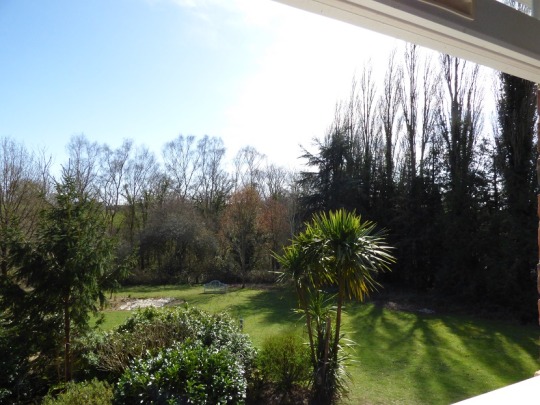
The field directly across the lane played a big part in the Blog and we knew something was going to happen there this year when the farmer started readying the land.

April saw one of the last chem trails we were going to see in the sky for rather a long time.

Data from the Department for Environment, Food and Rural Affairs saw huge drops in nitrogen oxides and nitrogen dioxide between the beginning of the UK's first lockdown and April 30, with pollution down by 30-40%
source BBC
We felt safe walking down the lane as there was virtually zero road traffic. There are no footpaths where we live, no street lights either as it happens and no bus route, so it became very quiet.

‘Happy Rhubarby Anniversary’ a gift with food yards rather than food miles
It was during April that me and Crow celebrated 40 years of marriage. We’d been planning to take a little break away and to have a big family BBQ get together and neither of those things could happen. We had some lovely gifts and cards though and a nice enough time out in the garden.


One of our gifts was super thoughtful and hopefully long lasting

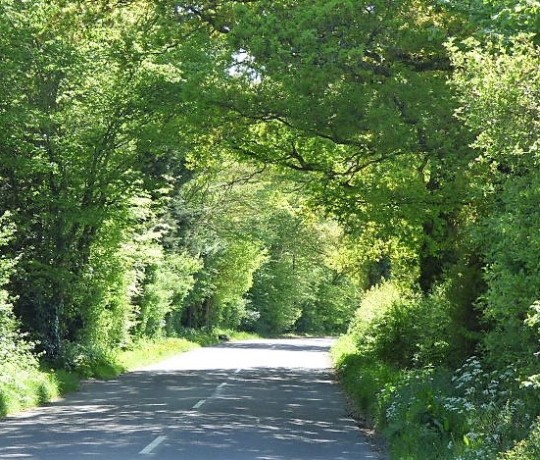
Everything around us started to flourish and of course we got out and about to see it all, got some exercise and had a change of scene (on foot only) It was just so peaceful everywhere/
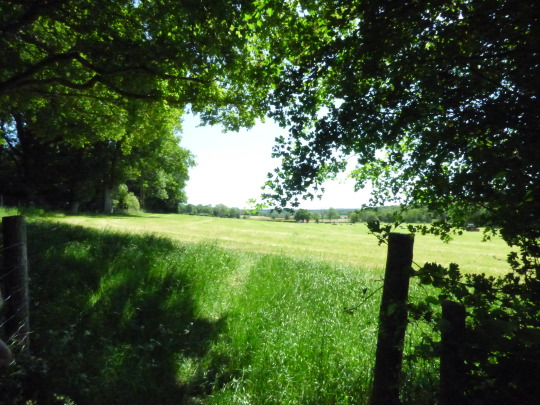
I featured a series of photos of the line of trees in our back garden ‘The Apostles’ viewed from around the local area, so we always knew when we were looking towards home.


The wildlife thrived. Pheasants are always a feature of my photo album and love a good pose, but I managed to start capturing a few shots of insects, dragon flies and damsel flies (below) which are not such easy subjects.


It’s no secret how much I love the Spring time and the new baby lambs and rabbits. I can’t believe how many photos I have of them and can stand for hours just watching the lambs skipping around and playing together.

Cheeky! location just the other side of the front door. You’re not coming in.

I was thrilled to bits when the Long Tailed Tits returned to the feeders as they pass from the woods to the conifers, I always miss them when they’re not around and we were delighted by all the wild flowers in the verges. There were some great homes for all the insects this year.

Goldfinches have usually come in to the garden but it became a standing joke that the moment my finger hit the camera button they’d have gone a split second before...but that began to change.


Notice on the ground at the local railway station
Meanwhile we were listening to daily briefings from the Government and the advice about how we should behave started to evolve.

People were doing all kinds of sponsored and public spirited things including 99 year old Captain Tom Moore walking in the garden, with the aid of his frame. It started off as a family sponsored effort but caught the public imagination and he went on to raise £38.9 million, including gift aid which went to charities associated with the National Health Service and its workers.

Captain Tom Moore knighted on 18th May - which just happens to be the birthday of the younger Ms Nature Watch (Ms NW tY)

At home we had two major players in the story of new life. Above ‘Daisy Waldron’ Wood Pigeon of this Parish, who nested right outside the front bedroom window where I look across to the field. Below some shots taken from the back of our hallway following the calamitous exploits of Tracey Song Thrush who needs to learn a thing or two about nest building.
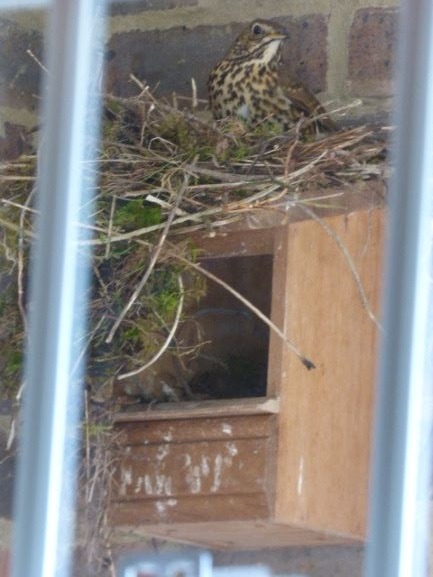
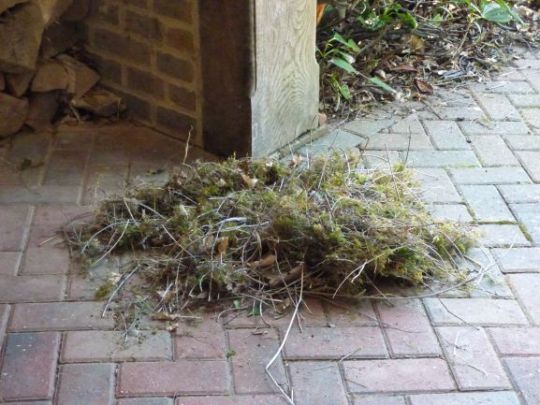
We gave her a bit of a helping hand and she cottoned on, but the nest wasn’t successful this time.

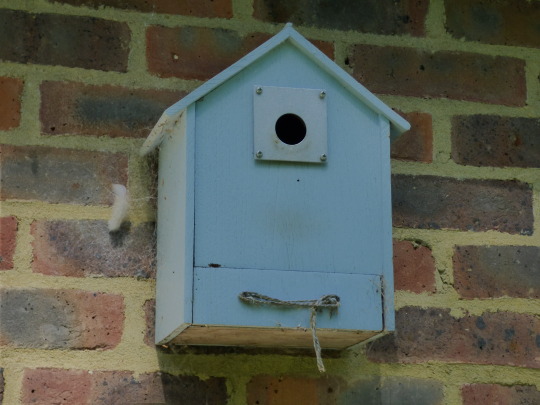
There was drama over this side wall nest box too. Who would win possession in the end? The Great Tits or the House Sparrows?
The House Sparrows prevailed and eventually reared two successful broods.
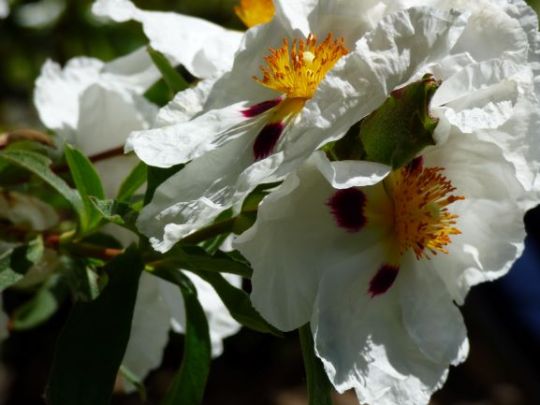
Cistus in the garden. We had two rogue blooms with the pink stripe

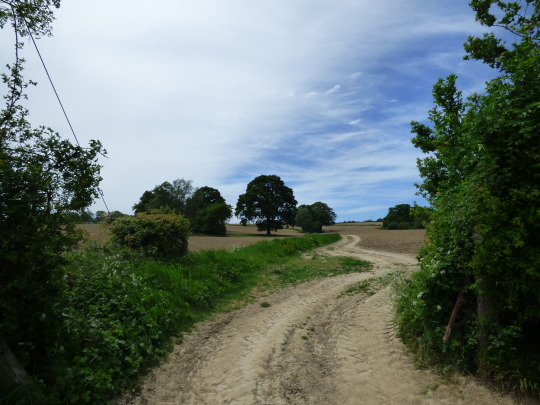
Our walks took us up through the Hop Gardens and I researched and wrote quite a bit about Hops and Oast Houses. It was interesting watching them grow. I was just disappointed that we missed the harvest. Doh! Won’t make that mistake again.
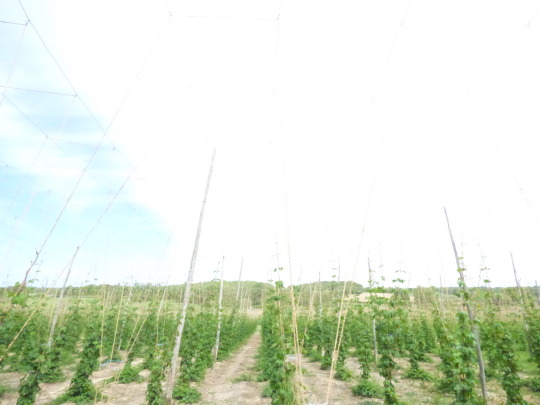
And we had a very unexpected and lovely visitor one evening. We’d never seen a Badger in the garden before let alone right up by the house.
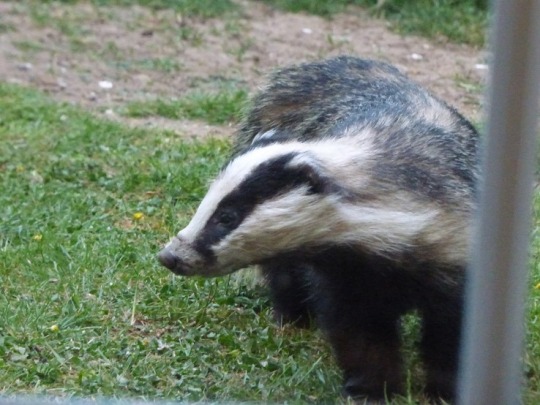
Badger at the kitchen window June

There were two new-to-us sightings of birds. Linnet (above) and Whitethroat (below) showing how little a distance you have to walk from home to see something entirely different. Our garden is fairly unkempt with a few wild areas, native hedging and lots and lots and lots of trees with woodland beyond. Surrounding the house are fields and different types of hedgerows, ponds and pockets of woodland. There were plenty of Swallows and Swifts down the lane too.

Back on home turf it was proving to be a really good breeding year.

Male Great Spotted Woodpecker feeds his youth (with the red cap on top of its head)
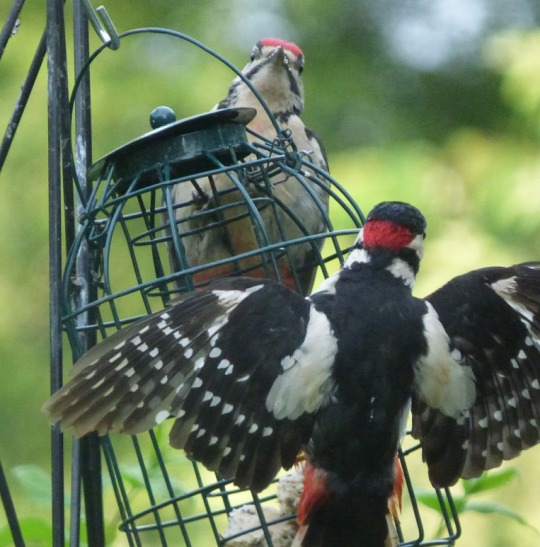
It was while we were watching the Woodpeckers in late June, when the feeders were temporarily relocated to the Conifer row, that I had an enormous and very welcome surprise.

Could I be right? Is that fuzzy green outline in the background really what I think it might be? I was feeling Eagle-eyed but I do have a bad habit of trying to turn things into what I want to see, rather than what they actually are. However, YES, after a total absence of more years than I can even remember, Greenfinch were back! I’ve kept on saying that our garden is blessed with various kinds of Tits - Blue, Great, Coal, Marsh and Long Tailed, but light on Finches. Greenfinch had deserted us, Bullfinch, rare and in fact not seen at all throughout 2020. Goldfinch, dare I say it, very flighty and Chaffinch in decline. The sighting of a Greenfinch made me unbelievably excited and happy and later on we had juveniles visit for food too. Happily it seems Chaffinch also had a good season and of course, Goldfinch turned up trumps and even let me get some photos. They’ve been seen here as late as New Year’s Eve 2020 when I’ve only ever seen them in the garden during Summer. These are all excellent signs and I just want the Bullfinch to buck their ideas up too now, I’ve been flirting with a very promising photo from the front hedge, but I know it’s a House Sparrow really.
And we’ll never know if Tracey was able to nest elsewhere, but we did have young Song Thrush from someone.

This was the first time we observed a Kestrel close by. She nested extremely close to where we’d seen Little Owls for a couple of years and she raised two chicks. One day she actually came hunting in our garden. We saw all three Kestrels regularly on our walks up past the farm and liked to watch the youngsters’ flying practice.

I’ve got to mention it. After thinking the Season may have to be cancelled, play had resumed behind closed doors (no fans present)
25th June, Liverpool FC’s 30 year wait to become Premier League Champions is over.

I won’t go on. Sad though that we’ve been denied the victory parade we’ve been waiting for - we had loose plans to go up to Liverpool. Oh well, the achievement’s there in incredibly difficult circumstances and the trophy cabinet’s been upgraded.
Decoration of the Day:
White silk horses bought in Hong Kong so long ago it was before the handover in July 1997

Music Choice:
Music of the Day because. Championes.
LoLa and Hauser perform piano and cello.
youtube
0 notes
Text
Tuesday 7th April
Collective Nouns for Birds
When I was at Primary School we used to have a lesson just called General Knowledge. It was always one of my favourite lessons and so much of what I learned back then has stayed with me. Collective nouns for things I’ve never forgotten and when I came across the question of nouns for birds recently some I remembered fondly and some I disputed or were new to me. It lead me into wondering how regional some are and how apt, or otherwise.
Buzzards: a wake. Not sure I’ve ever seen more than three Buzzards together and they were obviously a family.
Coots: a commotion. Well whoever decided on this one couldn’t have been more apt. In my experience Coots can cause a commotion in an empty pond and their nests look pretty much like a commotion too (taken at a pond a few minutes’ walk away)

Crows: a murder. I love Crows, they’re so intelligent and also very amusing to watch. Beyond our official garden is a large area of woodland population by huge black birds of varying kinds. Crows, Rooks and Jackdaws will often descend on the lawn together and our collective nickname is the Jets and the Sharks. It’s hard to get a photograph of just how many can be here at the same time and how they hop and dance together in a choreography of movement with wings waving.

Cuckoos: an asylum. I can’t say that I’ve ever spotted a Cuckoo and have only ever heard a single one. They must be there, but as one of life’s mysteries
Finches: a trembling. How sweet. On a more serious note, Finches are not very evident in our garden. The Greenfinch sadly disappeared altogether and quite a good number of years ago, maybe more than 12. We do get Chaffinch and infact I saw a pair yesterday, which was something to remark on.


Goldfinch are around and about and it’s exciting when they visit and I’m still waiting for this year’s first sighting of Mr and Mrs Bullfinch now that their favourite Amelanchier lamarckii is in full bloom (seen above in a distant shot)

The blossom is followed by berries, which are always stripped from the tree. When we did the garden here we planted quite a lot of mixed native hedging which has matured very nicely. We had five new trees in the front garden and eight at the back and made sure that the plants and shrubs we chose are bird, bee, butterfly and insect friendly.
Flamingos: flamboyance or stand. There’s something absolutely wonderful about contemplating a Flamboyance of Flamingos. It’s a new term to me, but one I won’t forget.
Geese: skein, wedge, gaggle, plump. Etched on my memory for all time...geese are a gaggle on the ground and a skein when in flight. This photograph taken in the field across the lane from us.

Kingfishers: a crown
Ravens: a conspiracy. I can well believe it! The only time I’ve seen Ravens is at The Tower of London. We were there last Summer on possibly the hottest day in decades when the Yeomen had to cut short their tours for fear of passing out in those thick woollen uniforms. We watched a couple of Ravens for quite a time, later using the shade of a canon as shelter and delighting in the echoes they could produce from the metal as they were cawing to each other. They drew quite a crowd.

Robins: a worm. I’ve never seen more than two Robins together at one time and they’d be either a pair at this time of year, or two battling for territorial rights, or a parent and chick. I’d have thought someone could’ve come up with a better name than a Worm.
Rooks: a clamour - see as per Crows above

Skylarks: an exultation. How wonderful a thought.
Starlings: chattering, affliction, scourge. Definitely a chattering as far as I’m concerned. Even if you’re not watching, you know when they descend as the noise level and squabbling is immense.

Starlings - flying in formation: a murmuration. NB link not updated since Covid-19 restrictions on travel
Wrens: a chime. The lovely little Wren deserves such a quaint description, Again, I only usually see them visit alone.
Nuthatches: a booby. Ha Ha. Not come across that term before, I wonder who dreamt it up and why?

Eiders: a quilt - how apt.
Magpies: a mischief ... even more apt.
Eagles: an eyrie - also the term used for the Eagles’ nest.
Owls: a parliament. This one sticks in my mind very clearly and for quite the wrong reasons depending on the politicians of the day. Also a Wisdom of Owls, which might be more appropriate.
Sparrows: a quarrel. We’re still lucky enough to have a thriving population of House Sparrows all around our garden. We have two personal collective nouns for them which no one will have heard before. One is The Hodders, after a local builder, because they’re so busy collecting nesting material and clearing out nesting material for refurbishments and the other is The Dirks (after an old neighbour - best not to ask about that one!)

Swallows: a kettle - not sure where to start to comment on that one.
Woodpeckers: a descent. I’d have applied that to Nuthatch and gone for a Cartoon of Woodpeckers, or a Tangle, based on my own observations. Another term is a Drumming - for very obvious reasons.

Turtle Doves: a pitying. How sad.
Jays: a scold. Not sure what behaviour prompted this description. Jays here are extremely shy and very hard to photograph as they’re so quick.
And lastly, an old favourite
Swans: wedge, ballet, lamentation, whiteness, regatta. The wedge, lamentation and whiteness can be forgotten as far as I’m concerned but the Ballet and Regatta are brilliant descriptions. Obviously not a bird I can observe at home, but always in mind as one of the most graceful and beautiful birds to watch... just look out as they can break your arm! Sorry Swans, it’s literally impossible to mention you in this house without adding that caveat.

More Collective Nouns to ponder on. There’s a comprehensive alphabetical list here. Note - with some variations from those quoted above.
♦ Outside links, shown in bold, are not affiliated
♦ I do proof read but please excuse errors and moments of brain freeze
0 notes
Text
How to Attract Owls and Why You Should Give a Hoot
Learning how to attract owls to your homestead has many rewards including acting as a natural way to get rid of mice. The joy of spotting the magical birds on evening owl prowls is also a reward in itself. Not as common as songbirds, when you spot an owl it is extra exciting.
Closing my poultry shed one evening, I heard an eerie, horse-like call from a cluster of oak trees in the corner of my yard. Half a minute later I heard a response in the forty-foot-tall clumping bamboo. I was surrounded, by pint-sized predators.
A few weeks later the screech owls had moved into one of the four nest boxes I had made. Soon after, two owlets flew the coop.
“By designing a garden that includes nesting and roosting habitat for owls, you will be availing yourself of the best possible organic pest control for your home and garden,” said Robert S. Mulvihill, the National Aviary’s ornithologist, and a well-known expert for information about birds who has been working with owls for 40 years.
Owl Nest Box
Screech owls make excellent neighbors as they work not only for free but throughout the night unseen. To invite owls to your homestead, build a nest box. Learning how to attract owls now is especially important as the owls will start nesting in early spring.
According to the Treasure Coast Wildlife Center, located in Palm City, Florida, screech owl distribution and abundance is determined by available nesting sites. The more boxes, the more owls. However, they are territorial so each box should be about 100 feet apart. Rough cut wood that weathers well, such as cedar, cypress or redwood is preferred, as the box should remain unpainted. The wildlife center recommends hanging the box on a tree, building, or pole about 15 feet high. The structure that the box is attached to should be at least as wide as the box. Place it on the edge of your treeline, close to an open yard.
Place wood shavings or pine straw into the nest as screech owls do not bring nesting materials. Do not use cedar shavings or sawdust. If starlings or sparrows begin to place their own nesting materials inside, remove them, as screech owls will not use an occupied box. American Kestrels, a small native falcon, will use the same type of nest boxes and can also be welcomed as a natural way to get rid of mice and insects. To attract these birds of prey, place the box higher, on an isolated live or dead tree. Although there are many designs, I like the Treasure Coast Wildlife Center’s blueprint the best. Dan Martinelli, Executive Director of the wildlife center has shared their simple nesting box made from a single 1” x 10” x 8′ board.
Ready to Start Your Own Backyard Flock?
Get tips and tricks for starting your new flock from our chicken experts. Download your FREE guide today! YES! I want this Free Guide »
Screech Owl Nest Box plans courtesy of Treasure Coast Wildlife Center.
My screech owl nest box with resident!
Where do Owls Nest?
“Owls nest everywhere,” said Mulvihill. “Several kinds of owls — including screech owls, northern saw-whet owls, elf owls and barred owls — nest in old woodpecker cavities and natural cavities in trees or in the West, saguaro cactuses. Barn owls even nest in old buildings.”
Mulvihill says that other owls like the great horned and long-eared prefer to nest in open stick nests in trees that they commandeer from crows or hawks. “Some nest on the ground —short-eared owl and snowy owl — and one species, the burrowing owl, nests in underground burrows made by other animals like prairie dogs and gophers,” he adds.
All of the cavity-nesting owls will sometimes use human-made nest boxes, too. “Barn owls, in particular, have been helped greatly by programs aimed at providing nest boxes for them in suitable grassland habitats both here in the United States and in Europe,” said Mulvihill.
Bob Mulvihill, the National Aviary’s ornithologist. Photo courtesy of National Aviary.
What do Owls Eat?
You may be wondering do owls eat chickens? Or will they eat my livestock? While owls are strictly carnivorous and eat a wide range of animals appropriate to their size, the likelihood of them hunting your diurnal livestock is small. “Many owls, like screech owls, will eat a wide range of prey from small mammals and birds to large insects,” Mulvihill says. “Others, like barn owls, feed more strictly on small mammals. The large great horned owl eats rabbits, rats, skunks and smaller owls.”
Barred owls, named for their beautiful barred chest feathers prefer mature riverine forest habitat and are known to feed on fish, crayfish, amphibians, and snakes. Unless your birds are unprotected during the night, owls shouldn’t be blamed as a chicken predator.
How Long do Owls Live?
Smaller species of owls can live up to 10 years, while the largest can live over 30 years. “Without exception, owls are beneficial as natural predators in the habitats and ecosystems that they inhabit; for humans, they can help control prey like mice and rats that sometimes can be considered nuisances or pests around homes,” said Mulvihill.
Backyard, Barnyard, Buddies
Barn owls have declined in numbers and many folks are now trying to attract them back to their homesteads. Barn owls are found worldwide. They can take up residence in abandoned sheds, barns and silos. Learning how to attract owls is easy: designate a rustic area to the garden where pruning and maintenance are kept to a minimum to encourage these birds to move in. Reducing widespread exterior lighting such as floodlights will also help.
Barn owl
One of the best hunting habitats for barn owls is rough grassland with a high population of field voles. If you own land in the countryside, a great way to encourage barn owls is to increase their food supply by creating patches of compact grassland with layers of dead grass for the vermin to live. Adding a bird feeder near a brush pile will invite songbirds to recycle your yard waste into nesting material. Leaving seeds and nuts on the ground will entice rodents which in turn brings the owls.
To keep the barn owls once you have attracted them, you can entice them by providing nesting and roosting places. Nest boxes similar to the former design are welcomed by the owls as long as the size is 12.5″ x 16″ x 22″ or larger. According to the Cornell Lab of Ornithology, barn owls are sensitive during the early phases of nesting in April and May and will abandon a nest if disturbed. Boxes can be placed in a variety of structures, including barns, silos, grain elevators, church steeples, or mounted on a free-standing pole.
Avoiding poisons, such as rodenticides will keep your birds safe. And since you’ll have these natural predators you will not need rodenticides.
Snowy owls are also often seen in wide-open spaces. If your northern homestead has a rolling terrain and is treeless, this owl might take up residency. Often seen sitting on the ground to hunt, they prefer land that offers them a view. In the winter they will also perch on fence posts, hay bales, buildings, and grain elevators.
Snowy Owl courtesy of National Aviary
Great horned owls are one of the largest species in the United States and can eat prey items as large as skunks. Leave large, bare branches or snags to encourage nest sites. These roosts will also serve as lookout posts for these perch and pounce predators.
Me holding a great horned owl. This bird is used in an education program at a zoological organization.
Owls serve an important ecological niche and help us out by eating crop pests. What types of owls have visited your homestead? Let us know in the comments below.
How to Attract Owls and Why You Should Give a Hoot was originally posted by All About Chickens
0 notes
Text
How to Attract Owls and Why You Should Give a Hoot
Learning how to attract owls to your homestead has many rewards including acting as a natural way to get rid of mice. The joy of spotting the magical birds on evening owl prowls is also a reward in itself. Not as common as songbirds, when you spot an owl it is extra exciting.
Closing my poultry shed one evening, I heard an eerie, horse-like call from a cluster of oak trees in the corner of my yard. Half a minute later I heard a response in the forty-foot-tall clumping bamboo. I was surrounded, by pint-sized predators.
A few weeks later the screech owls had moved into one of the four nest boxes I had made. Soon after, two owlets flew the coop.
“By designing a garden that includes nesting and roosting habitat for owls, you will be availing yourself of the best possible organic pest control for your home and garden,” said Robert S. Mulvihill, the National Aviary’s ornithologist, and a well-known expert for information about birds who has been working with owls for 40 years.
Owl Nest Box
Screech owls make excellent neighbors as they work not only for free but throughout the night unseen. To invite owls to your homestead build a nest box. Learning how to attract owls now is especially important as the owls will start nesting in early spring.
According to the Treasure Coast Wildlife Center, located in Palm City, Florida, screech owl distribution and abundance is determined by available nesting sites. The more boxes, the more owls. However, they are territorial so each box should be about 100 feet apart. Rough cut wood that weathers well, such as cedar, cypress or redwood is preferred, as the box should remain unpainted. The wildlife center recommends hanging the box on a tree, building, or pole about 15 feet high. The structure that the box is attached to should be at least as wide as the box. Place it on the edge of your treeline, close to an open yard.
Place wood shavings or pine straw into the nest as screech owls do not bring nesting materials. Do not use cedar shavings or sawdust. If starlings or sparrows begin to place their own nesting materials inside, remove them, as screech owls will not use an occupied box. American Kestrels, a small native falcon, will use the same type of nest boxes and can also be welcomed as a natural way to get rid of mice and insects. To attract these birds of prey, place the box higher, on an isolated live or dead tree. Although there are many designs, I like the Treasure Coast Wildlife Center’s blueprint the best. Dan Martinelli, Executive Director of the wildlife center has shared their simple nesting box made from a single 1” x 10” x 8′ board.
Ice Storms, Power Outages, Blizzards... Are you ready?
Let our experts help you prepare for the worst. Start your emergency preparation by downloading this FREE Guide. YES! I want this Free Report »
Screech Owl Nest Box plans courtesy of Treasure Coast Wildlife Center.
My screech owl nest box with resident!
Where do Owls Nest?
“Owls nest everywhere,” said Mulvihill. “Several kinds of owls — including screech owls, northern saw-whet owls, elf owls and barred owls — nest in old woodpecker cavities and natural cavities in trees or in the West, saguaro cactuses. Barn owls even nest in old buildings.”
Mulvihill says that other owls like the great horned and long-eared prefer to nest in open stick nests in trees that they commandeer from crows or hawks. “Some nest on the ground —short-eared owl and snowy owl — and one species, the burrowing owl, nests in underground burrows made by other animals like prairie dogs and gophers,” he adds.
All of the cavity-nesting owls will sometimes use human-made nest boxes, too. “Barn owls, in particular, have been helped greatly by programs aimed at providing nest boxes for them in suitable grassland habitats both here in the United States and in Europe,” said Mulvihill.
Bob Mulvihill, the National Aviary’s ornithologist. Photo courtesy of National Aviary.
What do Owls Eat?
You may be wondering do owls eat chickens? Or will they eat my livestock? While owls are strictly carnivorous and eat a wide range of animals appropriate to their size, the likelihood of them hunting your diurnal livestock is small. “Many owls, like screech owls, will eat a wide range of prey from small mammals and birds to large insects,” Mulvihill says. “Others, like barn owls, feed more strictly on small mammals. The large great horned owl eats rabbits, rats, skunks and smaller owls.”
Barred owls, named for their beautiful barred chest feathers prefer mature riverine forest habitat and are known to feed on fish, crayfish, amphibians, and snakes. Unless your birds are unprotected during the night, owls shouldn’t be blamed as a chicken predator.
How Long do Owls Live?
Smaller species of owls can live up to 10 years, while the largest can live over 30 years. “Without exception, owls are beneficial as natural predators in the habitats and ecosystems that they inhabit; for humans, they can help control prey like mice and rats that sometimes can be considered nuisances or pests around homes,” said Mulvihill.
Backyard, Barnyard, Buddies
Barn owls have declined in numbers and many folks are now trying to attract them back to their homesteads. Barn owls are found worldwide. They can take up residence in abandoned sheds, barns and silos. Learning how to attract owls is easy: designate a rustic area to the garden where pruning and maintenance are kept to a minimum to encourage these birds to move in. Reducing widespread exterior lighting such as floodlights will also help.
Barn owl
One of the best hunting habitats for barn owls is rough grassland with a high population of field voles. If you own land in the countryside, a great way to encourage barn owls is to increase their food supply by creating patches of compact grassland with layers of dead grass for the vermin to live. Adding a bird feeder near a brush pile will invite songbirds to recycle your yard waste into nesting material. Leaving seeds and nuts on the ground will entice rodents which in turn brings the owls.
To keep the barn owls once you have attracted them, you can entice them by providing nesting and roosting places. Nest boxes similar to the former design are welcomed by the owls as long as the size is 12.5″ x 16″ x 22″ or larger. According to the Cornell Lab of Ornithology, barn owls are sensitive during the early phases of nesting in April and May and will abandon a nest if disturbed. Boxes can be placed in a variety of structures, including barns, silos, grain elevators, church steeples, or mounted on a free-standing pole.
Avoiding poisons, such as rodenticides will keep your birds safe. And since you’ll have these natural predators you will not need rodenticides.
Snowy owls are also often seen in wide-open spaces. If your northern homestead has a rolling terrain and is treeless, this owl might take up residency. Often seen sitting on the ground to hunt, they prefer land that offers them a view. In the winter they will also perch on fence posts, hay bales, buildings, and grain elevators.
Snowy Owl courtesy of National Aviary
Great horned owls are one of the largest species in the United States and can eat prey items as large as skunks. Leave large, bare branches or snags to encourage nest sites. These roosts will also serve as lookout posts for these perch and pounce predators.
Me holding a great horned owl. This bird is used in an education program at a zoological organization.
Owls serve an important ecological niche and help us out by eating crop pests. What types of owls have visited your homestead? Let us know in the comments below.
How to Attract Owls and Why You Should Give a Hoot was originally posted by All About Chickens
0 notes